
How to Start a Blog in 11 Steps: Step-by-Step Guide
Table of Contents
It is very crucial to clear the fundamentals of blogging before deep diving or scaling your blog.
Hence, I decided to lay down a complete guide into a total of 11 fundamentals or steps, which cover every single topic that you must know as a beginner to expert your blogging skills.
If you have no time to read this guide make sure to bookmark this page for future reading purposes but I strongly recommend going through each step, if you want to learn blogging.
Remember more than 91% of published blogs never get organic traffic.
But, I believe if you understood the concept then you will be out of 91% of bloggers, who are not getting single traffic on this website.
Let first start with the basics of what is Blog.
Step 1: What is Blog and Why You should start a blog?
What is a Blog?
A blog is an online platform that allows writers to share their thoughts and experiences with a global audience. It’s a space that enables you to post content regularly, ranging from texts to multimedia (photos, videos, podcasts), and enables you to interact with readers through comments.
The Purpose of a Blog
The primary objective of a blog is to provide its audience with useful and relevant information across different topics. This information could be personal stories, industry news and trends, products, and services, opinions, or anything else that would be interesting or helpful to your readers.
Different Types of Blogs
There are several types of blogs, each serving different purposes and audiences. Here are some of these types:
- Personal blogs: where individuals share their personal experiences and lives.
- Travel blogs: where travelers share their experiences and discoveries.
- Food blogs: where foodies share their passion for cooking and eating.
- Business blogs: where companies share news about their products and services.
- Corporate blogs: where corporations share their values, missions, and ideologies.
- Professional blogs: where experts share their knowledge and insights about their industries.
- Tech blogs: where tech enthusiasts share their views about the latest gadgets and tech trends.
- Fashion blogs: where fashionistas share their love for fashion and beauty.
- Niche blogs: where bloggers focus on a specific topic or interest.
- Sports blogs: where fans share their insights and opinions about their favorite sports teams and athletes.
- Health blogs: where health enthusiasts share their tips and advice for a healthy lifestyle.
Why You Should Start a Blog
If you’re still on the fence about starting a blog, here are some reasons why it’s worth giving it a try.
Personal Growth and Development
Blogging can be an excellent tool for personal growth and development. By sharing your thoughts and experiences, you can reflect on your life, improve your self-awareness, and develop skills such as writing and communication.
Building a Community
When you start blogging, you’re not just producing content to be read by strangers. You’re also building a community of like-minded individuals who share your interests and values. Through your blog, you can connect with people from all over the world and exchange ideas and knowledge.
Networking and Professional Development
Blogging can also be a valuable tool for networking and professional development. Your blog can help you establish yourself as a thought leader in your industry, connect with other professionals, and build your network.
Marketing and SEO
If you have a business, blogging can be an effective marketing tool. By publishing high-quality content regularly, you can attract new customers, build brand awareness, and improve your search engine rankings. Your blog can also help you establish yourself as an authority in your industry, which can lead to more business opportunities.
In conclusion, blogging can be a powerful tool for personal growth, community building, professional development, and marketing. So, if you haven’t started a blog yet, what are you waiting for? Get started today!
generate passive income through blogging
Passive income generated through blogging refers to the revenue earned from a blog or website that continues to generate income even when you’re not actively working on it. Here are some common ways to generate passive income through blogging:
- Affiliate Marketing: This is one of the most popular methods of earning passive income through blogging. You can join affiliate programs and promote products or services relevant to your blog’s niche. When your readers click on your affiliate links and make a purchase, you earn a commission. It’s important to provide honest and valuable recommendations to maintain the trust of your audience.
- Display Advertising: Placing display ads on your blog can generate passive income. Services like Google AdSense allow you to display ads relevant to your content, and you earn money when visitors click on these ads or when the ads are displayed (impressions). As your blog traffic grows, your ad revenue potential increases.
- Sponsored Posts and Reviews: Once your blog gains popularity and has a significant following, you can collaborate with brands and businesses for sponsored posts and reviews. Companies may pay you to write content about their products or services, share your experiences, and provide links back to their website. Ensure transparency by clearly disclosing sponsored content to your audience.
- Digital Products: Creating and selling digital products such as e-books, online courses, templates, or stock photos can be a lucrative way to generate passive income. Once you’ve created the products, you can set up automated systems for sales and delivery. Marketplaces like Gumroad or platforms like Teachable can help you sell and distribute your digital products.
- Membership Sites: Building a membership site allows you to offer exclusive content, resources, or community access to your audience for a monthly or annual fee. This recurring revenue model can provide a steady stream of passive income while nurturing a loyal community.
- Ad Space Rental: If your blog has significant traffic and a specific niche, you can consider renting ad space directly to businesses. This approach allows you to negotiate higher rates and have more control over the ads displayed on your site.
Step 2: WordPress vs Blogger : Best Platform?
Introduction
When it comes to creating a blog, choosing the right platform can be a critical decision. There are many platforms available, but two of the most popular ones are WordPress and Blogger. In this article, we will compare the two platforms and help you decide which one is the best fit for you.
Definition of WordPress and Blogger
WordPress and Blogger are both content management systems (also known as CMS) that allow users to create and publish content such as blog posts, images, and videos.
Purpose of the Article
The purpose of this article is to provide information that can help you decide which platform is better for your specific needs. We will compare WordPress and Blogger based on ease of use, features, security, cost, support and community, ownership and control, portability and migration, design and aesthetics, and scalability.
Comparison Based on Ease of Use
WordPress
- User interface: The admin interface of WordPress is user-friendly and intuitive. It is easy to navigate and find what you need.
- Installation process: The installation process is straightforward and takes only a few minutes to complete.
- Plugins and themes: WordPress offers a vast selection of plugins and themes that can be installed with just a click of a button.
Blogger
- Dashboard interface: The admin interface of Blogger is also easy to use and intuitive. It is easy to navigate and find what you need.
- Built-in gadgets: Blogger has a range of built-in gadgets that are easy to use, such as a search bar and a comments section.
- Template customization: Customization options are limited but still allow for some basic changes to be made to the default templates.
Comparison Based on Features
WordPress
- Customization options: WordPress offers endless customization options. You can add functionality using plugins or create custom themes to fit your design needs.
- SEO optimization: WordPress is SEO-friendly by default, and there are many plugins available to improve SEO further.
- E-commerce capabilities: WordPress provides many plugins for building e-commerce websites with features like payment gateways and product listings.
Blogger
- Basic features: Blogger provides many basic features such as image uploading, HTML editing and embedding Google ads.
- Minimal customization options: While you can customize the templates available, the options are limited.
- Limited SEO optimization: There are some basic SEO options available but with limited control.
Comparison Based on Security
WordPress
- Regular updates: WordPress is constantly updated. This ensures improved security and new features for its users.
- Security plugins: With such a vast community, WordPress offers many security plugins allowing control over security on your website.
- Backups: Scheduled backups can be taken to protect content and any other material on a website.
Blogger
- Google’s security measures: As it’s owned by Google, Blogger utilizes the same security features, such as two-factor authentication to maintain website security.
- Less control over security: Although Google has a tight security regime, the owner of a blog has less control over website security measures.
Comparison Based on Cost
WordPress
- Free to use: WordPress is free to use, but hosting costs will apply. Users can establish their websites on shared or dedicated hosting.
- Premium themes and plugins: Some premium themes and plugins may carry extra costs – varying from one-time fees to annual licenses.
Blogger
- Free to use: Blogger is free to use, with no hosting costs. However, it has limited customization options.
Comparison Based on Support and Community
WordPress
- A large community of users and developers: WordPress has a massive community with many skilled users and developers always eager to help out.
- Various online resources and forums: WordPress offers many online learning resources, user groups, and forums dedicated to answering any questions.
- Online & offline support options: Many premium sites further supplement support by providing dedicated email and phone support options.
Blogger
- Limited community support: Although Blogger does have some user groups and forums, these cannot compare in number and activity level with that of the WordPress community.
- No official forums: There is no official support forum for Blogger.
- Email support by Google: Google provides email support options, but response times can be slow.
Comparison Based on Ownership and Control
WordPress
- Self-hosted platform: Hosting options provide complete autonomy over the content from every perspective.
- Ownership and control over all content and data: Everything is managed, right from which features one wants to enable to which data to be backed up.
Blogger
- Google-owned platform: Blogger is owned by Google, and, in reality, Google has substantive control over the content placed on the website.
- Limited control over data and content: Google retains significant control over every aspect of the blog.
Comparison Based on Portability and Migration
WordPress
- Easy to export data and migrate to another host: WordPress has the option to export/import blog data, making it easy to shift the website to another hosting provider.
Blogger
- Not easy to export data and migrate to another platform: Transferring a blog to another site builder is a tough nut to crack; the internal database system differs extensively from other non-Google-based site developers.
Comparison Based on Design and Aesthetics
WordPress
- Thousands of design options: One of the reasons WordPress outclasses other site builders is because of its endless design options for building and customizing themes, with some premium or paid templates available to choose from.
- Access to premium themes and templates: Users can buy premium themes with unique features and designs.
Blogger
- Limited design options: Although Blogger provides basic templates, customization options are limited.
- Basic customization options: You can change basic aspects of current templates, but access to premium themes and templates is not available.
Comparison Based on Scalability
WordPress
- Scalable platform: WordPress is inherently scalable, making it ideal for large websites and blogs.
- Suitable for large websites and blogs: With extensive plugin support and various optimization features, WordPress is no stranger to handling websites with massive traffic.
Blogger
- Limited scalability: Blogger has limited scalability as it is not a self-hosted platform. It is better suited to smaller websites.
Pros and Cons of WordPress
Advantages
- Customization options: WordPress’ endless design options give it an upper hand over other site-building websites.
- A large community of users and developers: The vast community of skilled users and developers provides plenty of learning resources and online support.
- Scalability: WordPress’s plugin functionality and optimization features enable it to work on larger websites.
Disadvantages
- Steep learning curve: Building on the WordPress platform requires a bit of practice with CMS features and a basic level of coding knowledge.
- Requires hosting costs: As it is self-hosted, hosting costs have to be incurred.
- Requires regular updates and maintenance: Plugins, theme updates, and core CMS updating require regular attention, especially to keep the website secure.
Pros and Cons of Blogger
Advantages
- Free to use: With no hosting costs, Blogger is a good platform for those who don’t want to invest much in their website.
- Easy to use interface: Blogger’s user-friendly dashboard interface and limited options make for an easy setup experience.
- Google’s search engine optimization benefits: As it’s owned by Google, Blogger can be useful for boosting a website’s rank in Google searches.
Disadvantages
- Limited customization options: Although some template variations can be chosen, the customization options are limited, making it less ideal for those who want a unique experience.
- Limited scalability: As it’s not a self-hosted platform, Blogger has limited scalability, particularly for those looking to establish larger sites.
- Limited control over data and content: Even though Google has site security and features in place, the site builder doesn’t provide significant control to the owners over data and content.
Step 3: What is Niche,and how to Choose Best Niche?
What is a Niche?
As a blogger, choosing a niche is one of the most important decisions you’ll make. A niche refers to a specific area of interest within a larger topic. Defining a niche means narrowing your focus to a particular subject or target audience. This could be anything from sports and fitness to travel or finance.
Importance of Niche Selection
Choosing a niche is critical if you’re serious about blogging. Here are some reasons why:
Improves Focus
By selecting a niche, you can concentrate your attention on a specific area of interest. This focus can help you develop expertise in your chosen area, which can help you produce higher-quality content.
Increases Expertise
Focusing on a niche can help you become an authority on a subject. As you curate and create content about your topic, you’ll develop a deep understanding of your niche. This can help you stand out in an oversaturated blogging market and attract more readers.
Enhances Creativity
Choosing a niche can encourage you to think more creatively about the content you produce. With a well-defined focus, you’ll find it easier to brainstorm new ideas for your blog.
Gains Followers
A niche blog attracts a specific audience. With the right niche selection, you can attract a dedicated group of readers who share your interests. These followers can help amplify your content by sharing it with their audiences.
Generates Income
Selecting the right niche can lead to monetization opportunities. By choosing a profitable niche and creating valuable content, you can attract sponsored content, advertisers, and affiliates.
Considerations for Choosing a Niche
There are several factors to consider when choosing a niche for your blog.
Personal Interest and Passion
Choosing a niche that interests you is essential to ensure that you stay motivated to produce content. Your passion for a topic will come through in your voice, and readers will appreciate the authenticity of your content.
Competition Analysis
Researching the competition can help you identify the best niche opportunities for your blog. Analyzing your competitors can help you determine how to differentiate your content and stand out in a crowded market.
Profitability Potential
While passion is crucial, choosing a niche that has money-making potential is essential for long-term success. Consider the current trends, audience demand, and profitability potential of your niche.
Audience Demand
Selecting a niche that resonates with your target audience is essential for attracting dedicated followers. Use social media platforms, keyword research tools, and surveys to determine the needs and interests of your audience.
Ability to Provide Value
Think about how you can create value for your readers through your content. Your blog should provide information, advice, or insights that are not easily found elsewhere.
Steps for Finding a Profitable Niche
Research
Conduct thorough research on your target audience, competitors, and top-performing blogs within your niche. Use social media platforms, search engines, and analytics tools to identify trends, keywords, and content gaps.
Brainstorming
Use your research to brainstorm key topics and themes that will attract your target audience. Consider your passions, skills, and experience when generating ideas.
Analyzing Competition
Analyze your competitor’s content, audience, and social media engagement to identify areas where you can differentiate your content from the competition.
Identifying Target Audience
Identify your target audience based on demographics, interests, needs, and goals. This information will help you create relevant and engaging content.
Testing Ideas
Before committing to a niche, test your ideas by creating a few pieces of content and analyzing audience engagement and website traffic.
Top Blogging Niches
Personal Development
Personal development encompasses a broad range of topics, from self-help to productivity to goal setting. This niche is popular with readers who are looking to improve their lives.
Health and Fitness
The health and fitness niche includes topics such as nutrition, exercise, and wellness. This niche is popular with readers who are looking to improve their physical health and mental well-being.
Technology
Technology is a popular niche that includes topics such as software, hardware, and gadgets. This niche is popular with readers who are interested in staying up to date on the latest tech trends.
Finance
The finance niche includes topics such as investing, budgeting, and personal finance. This niche is popular with readers who are looking to improve their financial literacy and achieve their financial goals.
Food and Cooking
The food and cooking niche includes topics such as recipes, cooking techniques, and restaurant reviews. This niche is popular with readers who are passionate about food and cooking.
Travel
The travel niche includes topics such as destination guides, travel tips, and travel gear reviews. This niche is popular with readers who are looking to plan their next adventure.
Education
The education niche includes topics such as e-learning, homeschooling, and education technology. This niche is popular with readers who are interested in lifelong learning.
Beauty and Fashion
The beauty and fashion niche includes topics such as makeup tutorials, fashion advice, and skincare tips. This niche is popular with readers who are interested in beauty and fashion trends.
Art and Design
The art and design niche includes topics such as graphic design, photography, and illustration. This niche is popular with readers who are interested in creative pursuits.
Mommy Blogs
Mommy blogs are a popular niche that includes topics such as parenting, family life, and child development. This niche is popular with parents who are looking for advice and support.
Choosing the Best Niche for Blogging for Beginners
Starting a blog can be overwhelming, but choosing the right niche can make the process easier.
Starting with a Broad Niche
Starting with a broad niche can help you determine what topics and themes you enjoy writing about the most.
Narrowing Down Over Time
As you gain more experience writing in your niche, you can begin to narrow down your focus to specific topics and themes.
Identifying Current Trends
Stay up to date on current trends within your niche by following industry influencers, reading news articles, and engaging with your audience.
Focusing on Quality Content
Quality content is essential to attract and retain your audience. Focus on producing content that is informative, engaging, and relevant to your target audience.
Building a Relationship with the Audience
Building a relationship with your audience is key to long-term success. Encourage engagement through comments, social media, and newsletters.
Monetizing a Niche Blog
Monetizing your niche blog can help you earn income from your passion.
Affiliate Marketing
Affiliate marketing involves promoting other businesses’ products or services in exchange for a commission.
Sponsored Content
Sponsored content involves working with businesses to create content that promotes their products or services.
Ads
Ads involve placing ads on your website and earning revenue based on clicks or impressions.
E-Products
E-products such as ebooks, courses, and templates are a great way to monetize your blog and share your expertise.
Services
Offering services such as consulting or coaching can help you earn income by providing value to your audience.
Common Mistakes to Avoid While Choosing a Niche for Blogging
Choosing a Niche for the Wrong Reasons
Choosing a niche solely based on profitability potential or current trends can lead to burnout and a lack of motivation.
Not Doing Enough Research
Failing to research your niche, target audience, and competition can lead to poor content quality and a lack of readership.
Going Too Broad
Choosing a niche that is too broad can make it difficult to differentiate your content and attract a dedicated following.
Not Being Original
Copying your competitors or producing content that lacks originality can lead to a lack of engagement and a lack of readership.
Giving Up Too Soon
Blogging takes time and effort. Don’t give up on your niche too soon. Stay consistent and continue producing quality content.
How to Stay Motivated While Blogging in a Chosen Niche
Setting Achievable Goals
Setting achievable goals can help you stay motivated and focused on producing quality content.
Connecting with Other Bloggers
Connecting with other bloggers can help you stay motivated and find inspiration for new content ideas.
Consistency Is Key
Consistency is key for building a dedicated following. Set a schedule for producing content and stick to it.
Experimenting with Content
Experimenting with different content formats, topics, and styles can help you find what works best for you and your audience.
Enjoying the Process
Remember that blogging should be enjoyable. Focus on producing content that you’re passionate about and that provides value to your readers.
Step 4: What is Web Hosting, Types, and How to Buy?
What is Web Hosting?
At its most basic level, web hosting simply refers to the service provided by companies that allow individuals and businesses to get their website online and accessible to Internet users. Web hosts make this possible by renting out server space to users, which they can then use to store and host their website files.
Importance of Web Hosting
Choosing the right web hosting provider is critical for the success of your website. Your hosting provider can determine your website’s uptime, loading speed, and overall performance. A good web hosting provider should offer reliable performance, security, and technical support.
Types of Web Hosting
Shared Hosting
Shared hosting refers to a type of hosting where a large number of websites are housed on a single server. This is a popular and cost-effective option for many small businesses and personal websites.
Explanation
Shared hosting is cheap because resources like CPU, memory, and bandwidth are shared among different websites. This also means that your website’s performance can be affected by other websites on the same server.
Pros and Cons
Pros:
- Affordable
- Easy to use
- Beginner-friendly
Cons:
- Not suitable for high-traffic websites
- Limited flexibility
- Limited resources
Virtual Private Server (VPS) Hosting
VPS hosting provides users with a virtualized server environment where they share a physical server, but each user has additional control and privacy as if they have a dedicated machine.
Explanation
A VPS provides a dedicated virtual resource allocation to each user. This means that you can customize your server environment and install any software you need for your website to work.
Pros and Cons
Pros:
- High-performance hosting
- Greater flexibility and scalability
- More control over server environment and configuration
Cons:
- Can be more expensive than shared hosting
- Requires some technical knowledge to set up
- Managing the server can be time-consuming
Dedicated Server Hosting
With dedicated server hosting, users have the entire server exclusively for their use. This option is suitable for large businesses that require high-performance hosting resources.
Explanation
A dedicated server gives you complete control over your resources, including CPU, RAM, storage, and bandwidth. This level of control enables you to customize and configure your server to your specific needs.
Pros and Cons
Pros:
- High-level of security
- Excellent performance and uptime
- Full control over the server
Cons:
- Expensive
- Requires technical expertise to manage
- Not a good choice for small businesses or personal websites
Cloud Hosting
Cloud hosting is a type of hosting where your website is hosted on a cluster of servers. This hosting type provides scalable resources based on your website needs.
Explanation
Cloud hosting uses multiple servers, with each server providing different aspects of your website’s hosting. This means that there is always an available server to meet your website’s capacity requirements.
Pros and Cons
Pros:
- Highly scalable
- High availability
- Pay-as-you-go pricing
Cons:
- Can be expensive, depending on the usage
- Requires technical knowledge
- Not always customizable
WordPress Hosting
WordPress hosting is specifically tailored for WordPress websites. This is a managed hosting option that comes preconfigured for WordPress sites, with a suite of tools to optimize and manage the WordPress platform.
Explanation
WordPress hosting is optimized for the WordPress platform and includes features, such as one-click installations, automatic WordPress updates, and WordPress-specific security measures. This hosting option is tailored to suit the specific needs of WordPress websites.
Pros and Cons
Pros:
- Automatic WordPress updates
- Easy WordPress installation
- Scalable resources
Cons:
- Limited to WordPress users
- Can be more expensive than shared hosting
- Limited customization
Factors to Consider When Choosing a Web Hosting Provider
When selecting a web hosting provider, there are several factors to consider to ensure that you choose the right provider for your website’s needs.
Pricing
Pricing is a crucial consideration when choosing a web hosting provider. You’ll want to select a provider that offers competitive pricing while providing the necessary hosting resources.
Server Location
The location of your web hosting server can affect your website’s load time and overall performance. Consider a provider with servers in your target market to get the best speed.
Uptime
Uptime is the time your website is accessible online. Look for a web host provider with a reliable uptime history.
Security Features
Security is an essential aspect of web hosting. Look for a hosting provider with advanced security features like SSL certificates, firewalls, and malware detection.
Scalability Options
Your website may experience growth over time. Consider a provider that allows you to easily upgrade your hosting plan if your website’s traffic increases.
Support Services
Good technical support is vital for web hosting. Select a provider with 24/7 support, live chat support, and responsive customer service.
Bonus Tip : My recommendation is to go with shared hosting, almost every beginner start with shared hosting which will cost you not more than Rs. 2,868/- Year, are you ready to buy the best hosting service?
How to buy Best Web Hosting?
Honestly, there are more than 60+ best hosting provider companies but only a few offer the best services at a competitive rate.
In this list, the below three are my primary choice in order of their popularity and affordable prices.
- A2 Hosting
- Bluehost
- Hostinger
But Hostinger Hosting is my topmost choice and even more than 5 of my blogs hosted on Hostinger hosting for the past 1 year, do you know why?
- Hostinger Hosting offers 5x faster speed as compared to others.
- Anytime money-back guarantees, no other hosting provider offers such a deal.
- 99.9% uptime which ensures close to a 1-minute outage every month.
- Free SSL with unlimited bandwidth and SSD storage under every plan.
- Their prices are very affordable for a shared hosting plan.
- 24*7 Customer support through online chat, call E-mail,, or support ticket.
- Hostinger hosting optimized WordPress with an inbuilt image compressor,dB caching, and turbo server.
- Hostinger hosting optimized plugin of Hostinger hosting offers the same class of optimization which you will get in managed WordPress hosting.
Hostinger Hosting is confident about its services including the fastest loading speed with 99.9% uptime and an Anytime money-back guarantee that will give you a reason to try it as long as you want.
Do you remember the point we discussed about the loading speed of the website?
Previously when I migrated my site to Hostinger hosting its loading speed reduced from 5 seconds to close to 1.5 seconds.
Isn’t it amazing
Believe me, Hostinger hosting is unbelievable and their customer reviews are amazing.
What is your thought? I made up my mind when I read the anytime money-back guarantee and hopefully you do too.
If so, then let me help you with Hostinger hosting plans and how to buy Hostinger hosting.
Hostinger hosting shared plan offers four hosting offers.
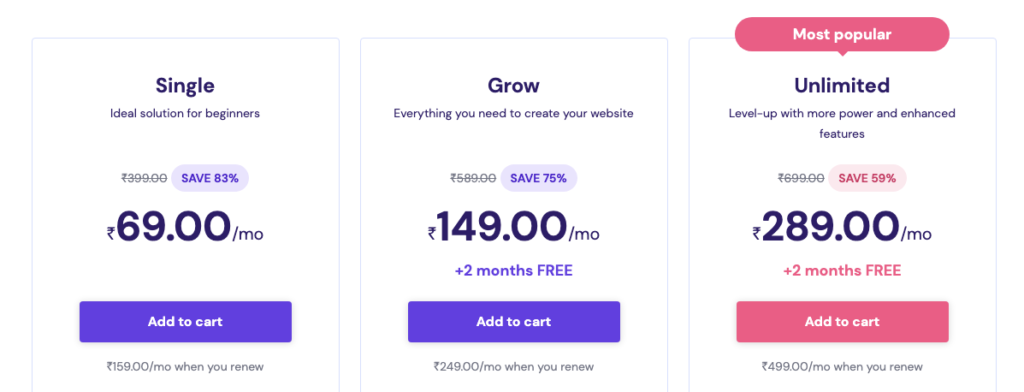
The best part is you will get the fastest speed in all three plans with SSD storage, which is 30 times faster as compared to other disk storage.
But their unlimited plan is 5x faster than all hosting
Bonus Tip : My recommendation is to go with GROW PLAN, which offers unlimited hosting, Free SSL and SSD storage, as you start blogging you will always have more than 1 blog.
Let me go through step by step guide on how to buy a Hostinger hosting account.
And you have a special offer of up to 70% OFF, so grab the deal as guided in further steps.
Step 1: Activate the Special Deal
Click to Activate Deal button for up to 70% off and it will navigate to Hostinger shared hosting plan page.
Step 2: Choose the web hosting plan
Click to Get GROW (or any other plan) and the promo code to get 70% off will be auto-apply to your account, Hurray!!

Step 3: Billing Cycle and Total Price

Step 4: Account and Personal details
Provide your customer or address details and this will be added as your communication detail in the hosting account.

Step 5: Payment and Checkout option.
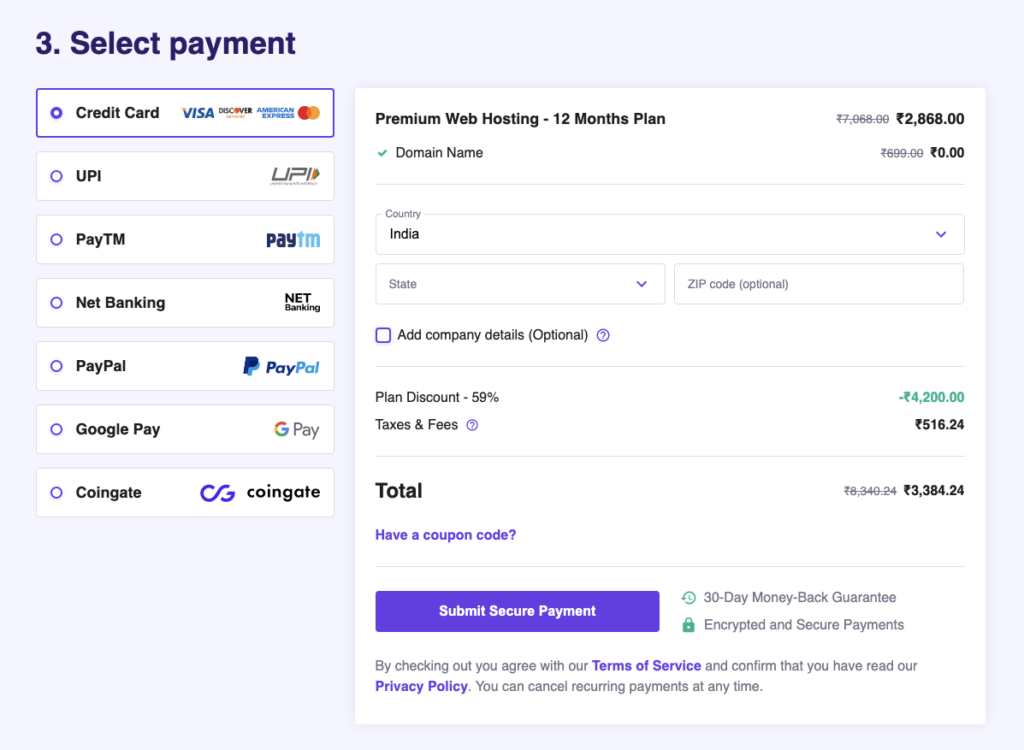
Congratulations, you have finished with the purchase of the best web hosting which ensures the fastest speed and unlimited storage to host a number of blogs.
Step 5: What is Domain Name and How to Buy?
Explanation of Domain Names
A domain name is a string of characters that identifies a specific IP address associated with a website. In simpler terms, it’s like a telephone number for a website. For example, google.com is the domain name for the website associated with the IP address 216.58.194.174.
Importance of Having a Domain Name
A domain name is a crucial element in establishing an online identity. It not only improves a website’s credibility but also makes it easier for customers to find it. In addition, it can be used for email addresses and serves as an asset that can be sold or transferred.
Overview of Domain Name Options
There are different types of domain names, each with its unique characteristics. Here are the main ones:
Top-Level Domains (TLDs)
TLDs are the highest level in the domain name system hierarchy. They are generally divided into two categories: generic TLDs (gTLDs) and country-code TLDs (ccTLDs). Some examples of gTLDs are .com, .org, and .net, while examples of ccTLDs include .uk for the United Kingdom and .cn for China.
Country Code Top-Level Domains (ccTLDs)
As mentioned earlier, ccTLDs are domain name extensions assigned to specific countries. They provide an effective means of geotargeting and establishing local web presence.
Generic Top-Level Domains (gTLDs)
gTLDs are not restricted to any particular country or region. They are commonly used for commercial purposes, such as .com, .net or .org.
Second-Level Domains (SLDs)
SLDs are the part of the domain name that comes before the TLD. For example, in the domain example.com, an example is the SLD.
Subdomains
Subdomains are part of a larger domain and are used to organize content or create separate websites. For example, blog.example.com is a subdomain of example.com.
Choosing the Right Domain Name
Choosing a domain name is a crucial step in building a website. Here are some important considerations to keep in mind:
Branding and Marketing Considerations
A domain name should align with your brand identity and make it easier for customers to find you online. It should be easy to remember, spell, pronounce, and not be too similar to other brand names.
Unique and Memorable Names
A unique domain name can help you stand out from the crowd, while a memorable one will help people remember your website address and return in the future.
Keyword-Rich Names
Using relevant keywords in a domain name can help with search engine optimization and improve overall visibility.
Research and Brainstorming Tips
Research and brainstorm multiple ideas to find the perfect domain name. Use a domain name generator, ask for feedback from friends and colleagues, and check for any trademark issues.
Availability Check and Domain Name Registration
Once you have chosen a domain name, the next step is to check its availability and register it. Here is how to proceed:
Checking for Availability
Use a domain availability checker to verify if the name of your choice is available for registration. There are many tools online that can help with this process.
Domain Registrars
A domain registrar is a company that provides domain registration services. Some popular domain registrars include GoDaddy, Namecheap, and Google Domains.

Registration Process
The registration process entails providing contact information, selecting an appropriate TLD or ccTLD, and making payment for the registration fee.
Renewal and Expiration
It’s important to keep track of your domain name’s expiration date to avoid losing it. Many domain registrars offer automatic renewal services.
Domain Name Servers
Domain Name Servers (DNS) are responsible for translating domain names into IP addresses.
Explanation of DNS
DNS serves as the internet’s phone book, translating domain names into IP addresses to direct traffic to the correct server.
DNS Configuration
DNS configuration includes modifying a domain name’s DNS settings to point it to the proper server. This process is typically done through a domain registrar’s control panel or other DNS management tools.
DNS Management and Troubleshooting
Effective DNS management involves monitoring DNS configurations and troubleshooting any potential issues. Common DNS issues include incorrect IP address assignments and outdated DNS records.
DNS Security
DNS security measures are vital to avoid domain name hijacking and other types of cyber-attacks. Common security measures include two-factor authentication and SSL certificates.
Domain Name Extensions
Choosing the right domain name extension is critical for SEO and user experience.
Explanation of Domain Name Extensions
Domain name extensions are the last part of a domain name (e.g., “.com”, “.org”, “.net”, etc.) that is added to the SLD to create a TLD.
Common Extensions and Their Uses
Some of the most common domain name extensions include .com, .org, and .net. Each has its unique use case.
New or Alternative Extensions
New or alternative extensions, also known as new gTLDs, are becoming more common. Examples of new extensions include .tech, .me, and .club.
Choosing an Extension for SEO and UX
Choosing a domain name extension that corresponds with a website’s purpose increases its visibility in search engine results and improves overall user experience.
In Conclusion, registering a domain name is a crucial step in building an online presence. This article provided an overview of domain name options, tips for selecting the right name, and the steps involved in checking availability and registration. Understanding DNS management and choosing the correct extension is also essential for an effective web strategy.
Step 6: Keyword research using Free and Paid Tools.
Keyword research is a crucial element when it comes to SEO. It helps to identify the search terms that people enter into search engines and build content that is relevant to these queries. Keyword research can be done using either free or paid tools, and both options have their pros and cons.
Importance of Keyword Research
Keyword research helps to guide the content creation process by providing insights into the most relevant and popular search terms within a particular niche or industry. By identifying these keywords, businesses can optimize their content to rank higher in search engine results pages (SERPs) and increase their website traffic.
Brief Overview of Free and Paid Tools
Free tools are great for businesses or individuals with limited budgets, while paid tools offer more features and advanced functionality. The choice between free and paid tools ultimately depends on the user’s needs and budget.
Free Keyword Research Tools
Here are some of the best free keyword research tools:
Google AdWords Keyword Planner
Google AdWords Keyword Planner is a free tool that helps businesses to find the most relevant keywords for their ad campaigns. To use this tool, you need to have a Google AdWords account.
Advantages:
- Provides keyword suggestions.
- Allows you to see search volume and competition level for each keyword.
- Helps you to plan your ad campaigns by showing estimated bids for each keyword.
Disadvantages:
- Limited in terms of data.
- Provides keyword suggestions based on AdWords campaigns only.
- Focuses mostly on PPC rather than organic search.
Google Trends
Google Trends is a free tool that helps businesses to see how search volume for a particular keyword has changed over time. This tool provides data on search trends for a particular keyword, as well as related keywords and topics.
Advantages:
- Allows you to see search volume over time.
- Helps to identify seasonal trends.
- Provides insights into related keywords and topics.
Disadvantages:
- Limited in terms of data.
- Does not provide an exact search volume.
- Does not provide information on the competition.
Ubersuggest
Ubersuggest is a free keyword research tool that provides keyword suggestions and other important data, such as search volume, CPC, and competition level. This tool can also help you to analyze the top-ranking pages for a particular keyword.
Use cases:
- Generating keyword ideas.
- Analyzing the competition for a keyword.
- Finding long-tail keywords.
Limitations:
- Limited in terms of data.
- Does not provide an exact search volume.
- May provide irrelevant keyword suggestions.
Keyword.io
Keyword.io is a free keyword research tool that helps businesses to generate keyword ideas based on what people search for across multiple platforms, including Google, Amazon, and YouTube.
Use cases:
- Generating keyword ideas.
- Finding long-tail keywords.
- Analyzing competition across multiple platforms.
Limitations:
- Limited in terms of data.
- Does not provide an exact search volume.
- May provide irrelevant keyword suggestions.
Answer the Public
Answer the Public is a free keyword research tool that helps businesses to generate long-tail keyword ideas based on what people search for in their question queries.
Unique features:
- Provides keyword suggestions in question format.
- Offers insights into what people ask and want to know about a topic.
- Helps to generate content ideas based on user intent.
Limitations:
- Limited in terms of data.
- Does not provide an exact search volume.
- May provide irrelevant keyword suggestions.
Paid Keyword Research Tools
Here are some of the best-paid keyword research tools:
Ahrefs
Ahrefs is a paid keyword research tool that helps businesses to analyze the competition, discover new organic search keywords, track rankings, and monitor backlinks.
Features:
- Provides keyword suggestions.
- Helps to analyze the competition.
- Tracks keyword rankings over time.
- Provides information on backlinks and referring domains.
Limitations:
- Expensive.
- May be overwhelming for new users.
- Not very beginner-friendly.
SEMrush
SEMrush is a paid keyword research tool that helps businesses to analyze their competition, discover new organic search keywords, track rankings, and monitor backlinks.
Features:
- Provides keyword suggestions.
- Helps to analyze the competition.
- Tracks keyword rankings over time.
- Provides information on backlinks and referring domains.
Limitations:
- Expensive.
- May be overwhelming for new users.
- Not very beginner-friendly.
Keywordtool.io
Keywordtool.io is a paid keyword research tool that helps businesses to generate keyword ideas from competitors, Google Autocomplete, and related searches.
Advantages:
- Provides keyword suggestions.
- Offers a variety of keyword sources.
- Easy to use.
Disadvantages:
- Limited in terms of data.
- Provides keyword suggestions based on Google Autocomplete only.
- Not very advanced.
Long Tail Pro
Long Tail Pro is a paid keyword research tool that helps businesses to generate long-tail keyword ideas, analyze competition, and analyze search engine results pages.
Features:
- Provides long-tail keyword suggestions.
- Helps to analyze the competition.
- Offers keyword difficulty score.
Limitations:
- Expensive.
- Limited in terms of data.
Moz Pro Keyword Explorer
Moz Pro Keyword Explorer is a paid keyword research tool that helps businesses to generate keyword ideas, analyze competition, and track rankings.
Features:
- Provides keyword suggestions.
- Helps to analyze the competition.
Limitations:
- Expensive.
- Not very user-friendly.
- Limited in terms of data.
Using Free and Paid Tools Together for Keyword Research
Using both free and paid keyword research tools together can help businesses to get the most accurate and comprehensive data possible. Here are some ideas for combining the data:
- Use free tools to generate keyword ideas and identify seasonal trends.
- Use paid tools to analyze the competition and track rankings.
- Use a combination of free and paid tools to find long-tail keywords and analyze user intent.
Keyword Research Tips and Best Practices
Here are some tips for conducting keyword research:
- Choose keywords that are relevant to your business or industry.
- Conduct competitor research to find keyword gaps and opportunities.
- Organize your keywords into groups.
- Implement your keywords into your website content and meta descriptions.
In summary, keyword research is an essential part of SEO that can help businesses to optimize their content and increase their website traffic. Whether you’re using free or paid tools, it’s important to choose the ones that are most relevant to your needs and budget. By combining the data from both types of tools, you can get the most accurate and comprehensive data possible. Lastly, following best practices and tips is crucial to generating useful and effective keywords that will help drive traffic to your website.
Keyword Research Using Paid SEO Tools
No one can deny how powerful these paid SEO tools are.
They are not only used to find profitable and easy-to-rank keywords within seconds but are also used on other Off-Page SEO techniques.
In this list, the two most popular tools are Ahref and Semrush. Yes, they are expensive enough to buy but very powerful.
Here is a summary of how to do keyword research using Ahref.
Step #1: Go to keyword Explorer in Ahref.

Step #2: Enter your seed keyword and choose the country for which you need to research and hit the search button.
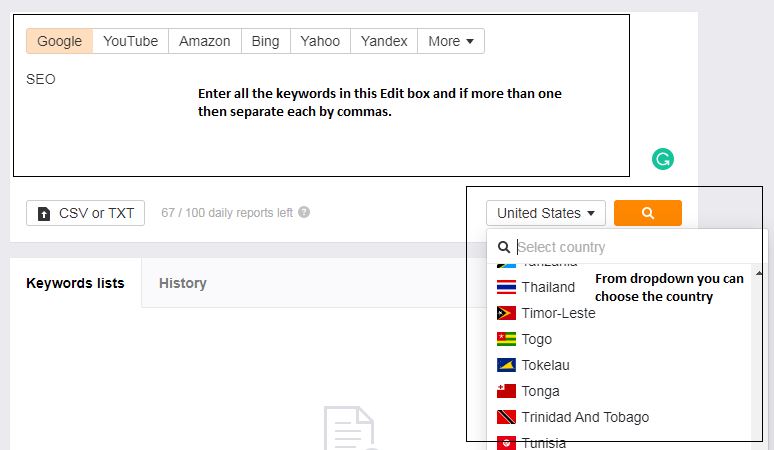
Step #3: You will have a full dashboard of keyword SEO difficulty, search volume, and a few more suggestions for our keyword SEO.
This keyword looks competitive as it is having a difficulty of 93, so you need to narrow down your search.
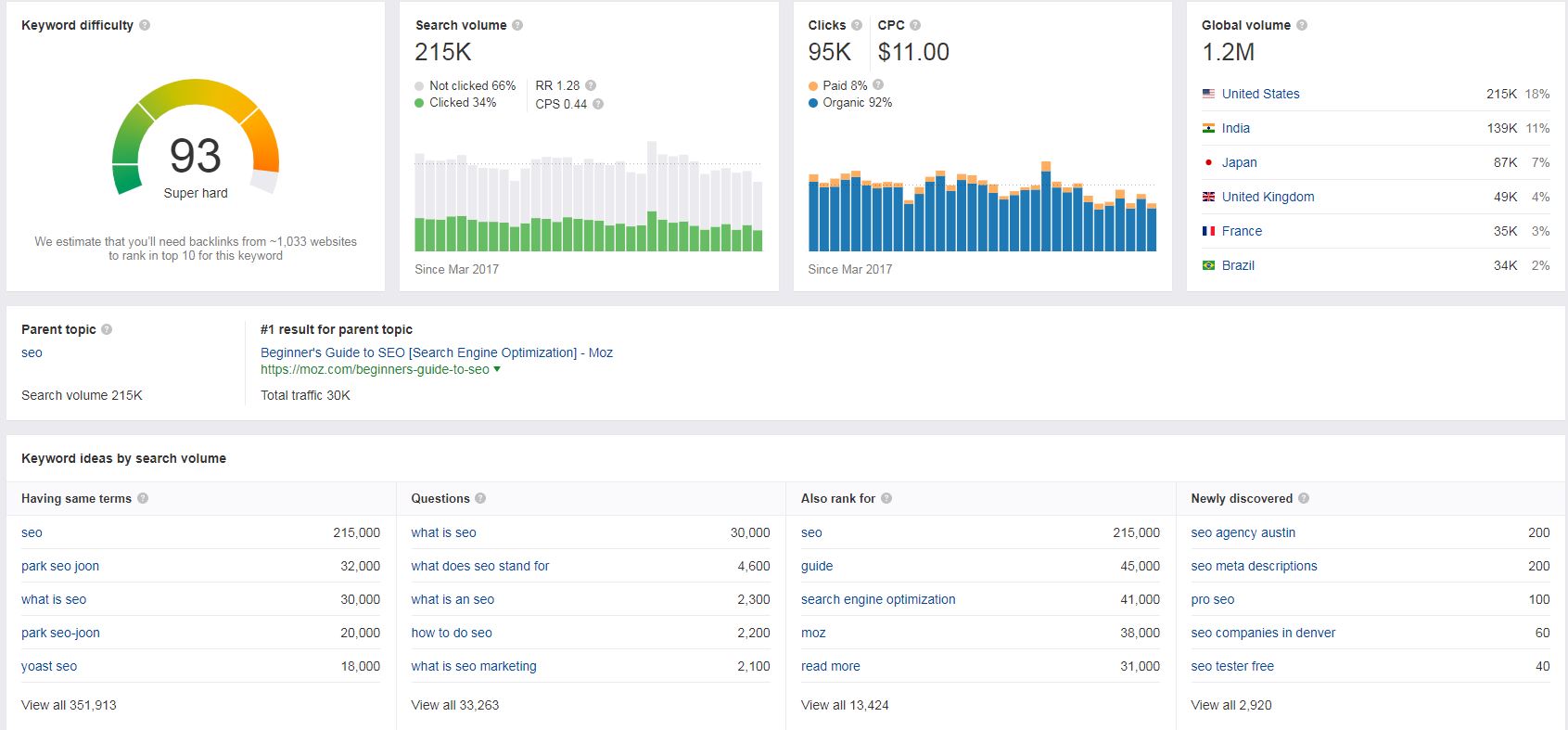
Step #4: o explore more keyword ideas click to have the same terms or the keyword ideas given under the section keyword ideas by the search volume.
You have more than 3,00,000 ideas to explore with low to high difficulty.
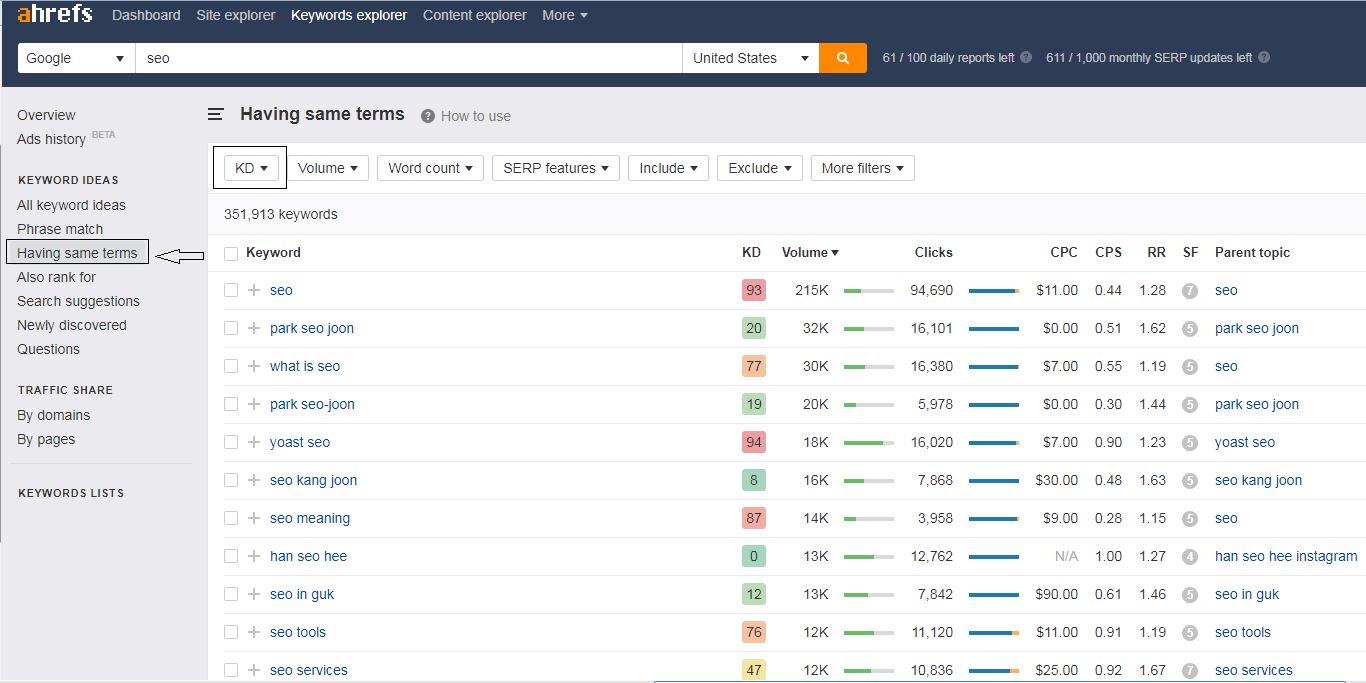
Step #5: You can see a different keyword with different difficulty, their search volume, and much more and for beginners, I would recommend finding a keyword with close to 0-10 difficulty.
So click on KD and in the drop-down select Min=0, Max=10 and click Apply then you have a collection of keywords with low difficulty.
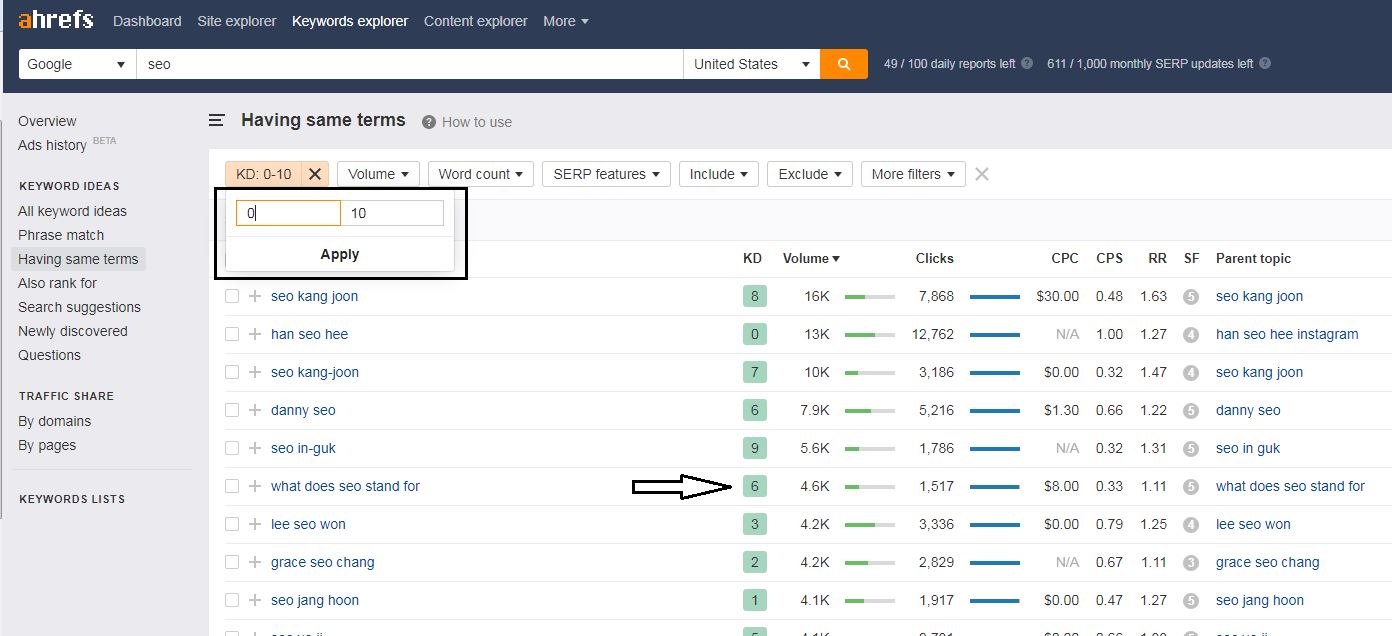
Boom!! you got the keyword “What does SEO stand for” which has a search volume of 6.5k and difficulty of just 6 which is very easy to rank.
It has various filters and you can try and run with a couple of hacks to get your best profitable keyword.
Similar way, I searched for the same keyword directly in keyword explorer which we searched in Ubersuggest what is SEO writing, and here we have search volume and difficulty.

Keyword analysis in paid SEO tools is always detailed and well-researched as compared to the free SEO tool and you will find differences between free and paid tools.
Bonus Tip : Finding a keyword is not the only criteria, to rank a post, you need to find a search query which fit with your keyword, so focus on search intent for instant results.
Step 7: How to find Content or Blog Post Ideas?
How to Find Content or Blog Post Ideas?
Are you struggling to come up with fresh and exciting ideas for your blog posts? Finding inspiration for content creation can be a daunting task, especially if you’re trying to stand out in a crowded niche. In this article, we’ll explore six different methods for finding content or blog post ideas, including scanning the news and trending topics, analyzing your competitors’ content strategy, conducting keyword research, tapping into your audience’s questions and feedback, repurposing existing content, and brainstorming and idea generation techniques.
Exploring Different Methods of Finding Content or Blog Post Ideas
Before we dive into the specific methods, it’s essential to understand that content creation should be a strategic and data-driven process. Your goal is to create content that resonates with your audience, addresses their pain points, and provides unique value. To achieve this, you need to have a clear understanding of your target audience, their preferences, and the keywords they use to search for information. Let’s explore six different methods for finding content or blog post ideas.
Scanning the News and Trending Topics
One of the easiest ways to find content ideas is to scan the news and trending topics on social media. By staying up-to-date with the latest news in your industry, you can create timely and relevant content that captures your audience’s attention. Here are some specific ways to do this:
- Set up a Google Alert for relevant keywords: This will send you email updates when new articles or news come up related to the keywords you want to monitor.
- Follow news sources and industry leaders on social media: Stay updated on the latest news and trends by following leading publications, experts, and influencers on social media. Twitter, LinkedIn, and Reddit are particularly useful for this purpose.
- Observe trending topics on Twitter and Reddit: Trending topics on Twitter or Reddit can be a great source of inspiration for content creation. You can also use tools such as BuzzSumo or Google Trends to identify trending topics related to your niche.
Analyzing Your Competitors’ Content Strategy
Another effective way to find content ideas is by analyzing your competitor’s content strategy. By understanding what topics your competitors are covering and how they’re performing, you can identify gaps in their content and areas where you can differentiate yourself. Here’s how to do this:
- Look at the most shared and commented blog posts or articles of your competitors: Tools such as BuzzSumo can help you identify the top-performing content of your competitors. By analyzing the topics and formats of their best-performing content, you can gain insights into what works for your target audience.
- Use tools like Ahrefs, SEMrush, or Buzzsumo to analyze content performance and backlinks of competitors: These tools can help you see which content is getting recommended and shared in your market. You can also identify gaps in the content and areas that consistently drive traffic and engagement.
Conducting Keyword Research
Keyword research is a fundamental aspect of SEO and content creation. By understanding the keywords your target audience uses to search for information, you can create content that’s optimized for search engines and meets their needs. Here are the steps to conduct keyword research:
- Use Google’s keyword planner or other keyword research tools to identify high-volume and relevant keywords for your niche: This will help you understand the topics and phrases that people are actually typing into search engines to learn more about your niche.
- Analyze the keywords’ search intent and create content accordingly: Ensure that the content you create aligns with the searcher’s intent. For example, if they’re looking for a quick answer, make sure to provide a concise solution in a list format.
- Make use of long-tail keywords and questions to cover various topics: Long-tail keywords and questions are great for targeting more specific topics within your niche.
Tapping into Your Audience’s Questions and Feedback
Your audience is the best source of inspiration for your content ideas. By listening to their questions and feedback, you can create content that addresses their needs and provides unique value. Here’s how to tap into your audience’s questions and feedback:
- Monitor comments, emails, and feedback from your audience: Engage with your audience on social media and reply to comments and messages. By doing so, you can learn more about their pain points and interests.
- Conduct surveys or polls to gather insights on their problems and interests: Use tools such as Typeform or SurveyMonkey to create polls and surveys that capture your audience’s feedback.
- Use Q&A platforms like Quora, Reddit, or LinkedIn to identify common questions: These platforms are great for identifying the most common questions and concerns of your target audience.
Repurposing Existing Content
Repurposing existing content can save time and effort while still providing unique value to your audience. Here are specific ways to repurpose your existing content:
- Update old blog posts with new information and visual assets: Add new information, images, or infographics to existing content to make it more engaging and up-to-date.
- Convert blog posts into infographics, podcasts, or videos: Turn blog posts into different formats to appeal to a wider range of learning styles and preferences.
- Use a content audit to identify underperforming content that can be reworked and repurposed: Evaluate the performance of your existing content and identify weak spots. You can then rewrite/rework it and publish it again.
Brainstorming and Idea-Generation Techniques
When you’re stuck in a content creation rut, brainstorming sessions can help you generate new ideas and get your creative juices flowing. Here are some techniques for idea generation:
- Use mind-mapping tools to create a visual representation of various topics: Tools such as Mindmeister or Coggle let you create mind maps that connect different topics and ideate around new themes.
- Set up brainstorming sessions with colleagues or freelancers: Collaborate with other writers or content creators to ideate and brainstorm.
- Use techniques like SCAMPER, SWOT analysis, or Random Word Generator: SCAMPER involves asking questions such as “How can we simplify our topic?” or “Can we add more value by including interviews?” SWOT analysis can help identify potential strengths, weaknesses, opportunities, and threats in your niche. A random word generator can help spark new ideas by giving you a random word to work with.
Criteria for Assessing Content or Blog Post Ideas
Not all content ideas are equal. Before you create content, it’s essential to assess whether the topic is worth investing your time and resources. Here are some criteria for evaluating the content or blog post ideas:
- Relevancy and Timeliness: Ensure that the topic is relevant to your niche and current events. Create a content calendar to plan ahead and address seasonal or trending topics.
- Target Audience and Message: Identify your target audience and their preferences. Use a clear message and tone that resonates with your audience.
- Originality and Value: Avoid duplicating content or ideas from others. Add value to existing topics by providing unique insights, data, or practical tips.
- Feasibility and Resources: Ensure that the topic can be realistically covered in terms of time, budget, and skills. Use available resources and tools to create high-quality content.
Find Post Ideas From Already Ranking Pages
Well, you know the focus for the keyword, which you are planning to target is to get #1 in SERP, so why don’t you focus on all the ranking pages?
So the easy step is to go into Google search and type your targeted keyword and go through all the ranking pages.
Analyze the title they have given for their web page and how the keyword is targeted in the title or H1 tag.
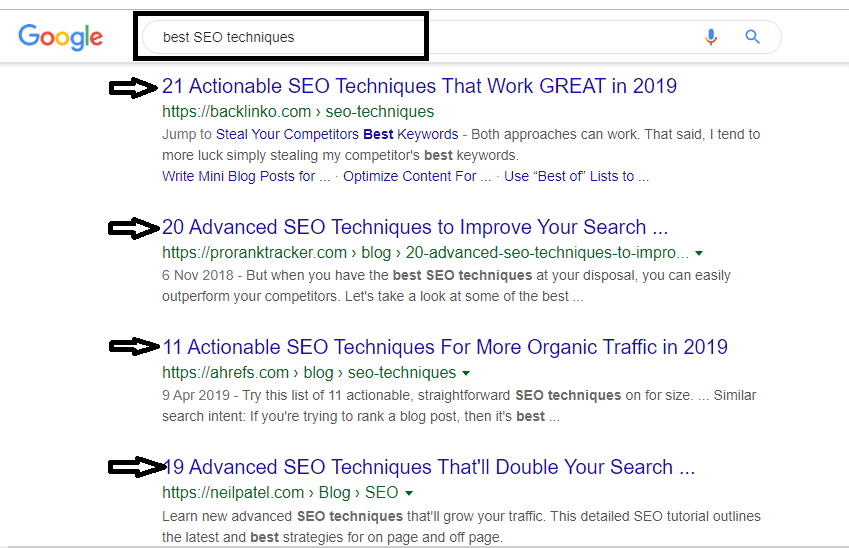
Well, I searched for the keyword best SEO techniques and here you can see all the top 10 ranking pages are having list posts where they explain the number of ways to do SEO.
Boom!! now if you have to target the same keyword then start focusing on writing a list post not any ultimate or step-by-step guide.
Find Post Ideas From Quora
Quora is a Q&A site and it has billions of search volumes every day, so why don’t you search there and try to find out what people are asking related to that keyword?
Here I searched in Quora for query Best SEO tools
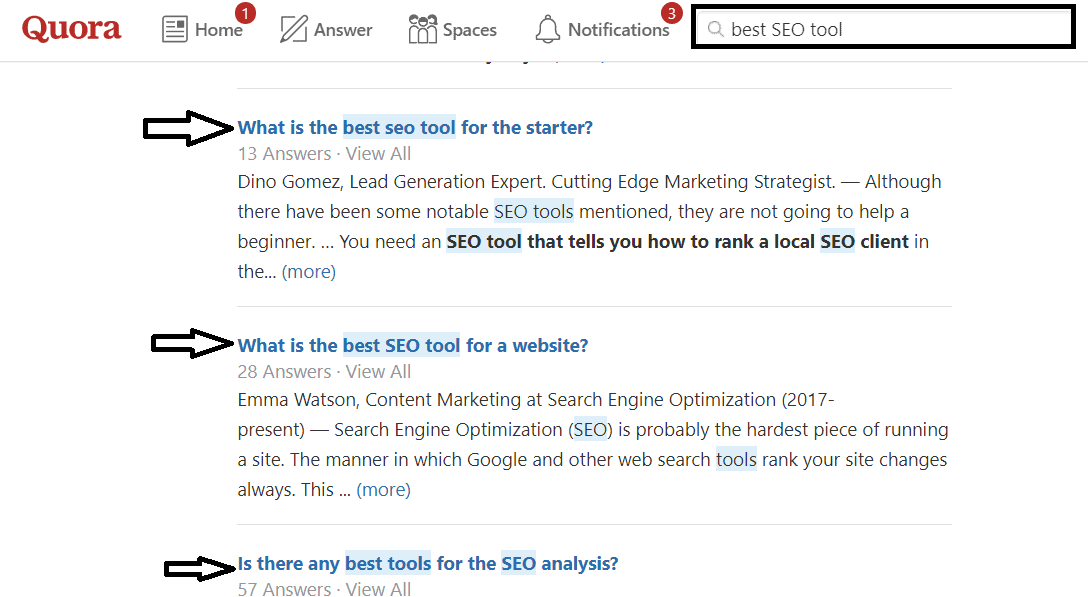
Quora gave ideas that are specific to best SEO tools, if you simply target a query Best SEO tools then it won’t rank but you can target posts like best SEO tools for the starter has likely more chance to rank.
Bonus Tip: In Quora always try to focus on those queries or post ideas that have the most number of answers or followers, which means more and more people are already searching for that query.
Find Post Ideas From Answerthepublic
Answerthepublic is the resource for all the queries searched on various platforms.
Go to their homepage and what they ask is just your seed keyword.
Then it will search all the databases of almost every platform and will create a collective list on different charts form or tabular forms which are downloadable.
Here you can see the results we searched for query best SEO Tools
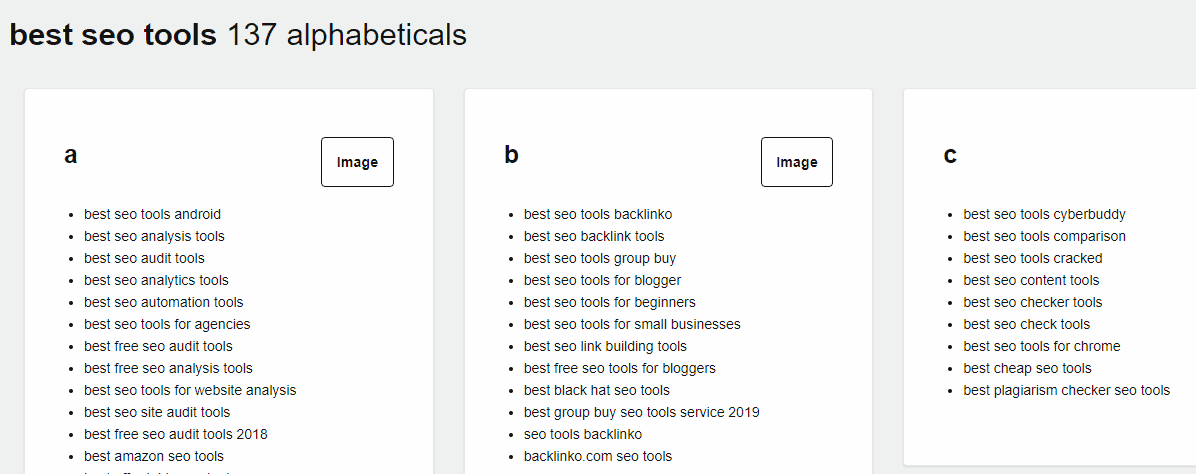
If you will scroll down, it has tons of other results. You can get more and more keyword ideas which later you can find difficulty in Ahref by entering hundreds of keywords at a time.
You can use this tool to find the long tail keyword ideas which are narrow-targeted and people are searching.
Bonus Tip :For more keyword ideas you can also search in Reddit, the most popular platform which has more than millions of queries posted every day,and you can join Reddit and sub-Reddit groups.
Step 8: Best WordPress Theme and Mandatory Plugin?
Theme plays a vital role in how a user will interact with the website and is also important in website loading speed.
Similarly, there are 1000s of plugins in the WordPress library, which are a must to improve the website security, and performance and automate most of the process.
Both Themes and plugins are available in Free and paid plans but for beginners, it is good enough to start with free and can switch later to pro plans,
Best WordPress Free And Paid Themes
WordPress has a collection of themes and you can use their limited features in their Free plans.
But all the free themes have limitations with customization of the website, such as font color, types, navigation menu, etc.
The theme must be lighter and should have faster-loading speed and in this list, there are several free and paid themes.
When I started my blogging, I used the very most popular Free theme, eStory. This theme is mobile and desktop friendly and can be used for any type of blog website.

As I said earlier, it will always have limitations to customizing the font colors, font types, content width, and menu customization but good enough to start.
But I do not recommend any Free theme to a beginner as ultimately you are going to change it somewhere in the next 1 or 2 months, because you should care about the user readability and engagement.
If a theme is not allowing to customize for certain features then you may lose much more traffic on your blog and maybe reverse impact on your site.
So the next option is to buy a lightweight best WordPress pro theme.
The best three premium themes are fit for any type of blog and optimize enough for desktop or mobile websites then you can choose from the below listed four themes.
- GeneratePress: The most recommended theme for every beginner, as it is a lightweight theme compatible with all types of WordPress blogs and even this blog is using the GeneratePress theme. Buy Now only Rs 99/-
- Astra Pro: Astra is among the topmost theme list, which is well fit for both blog and Ecommerce websites, they have their addons to customize your website very easily. Buy Now only Rs 99/-
- OceanWP Pro: If you plan to customize a website like an E-commerce shop or any product selling review website then OeanWP would be the best choice for you.
- Newspaper Theme: It is very popular among all the new bloggers and you can customize your blog like any magazine or news website pattern and a few other inbuilt templates. Buy Now only Rs 99/-
Q: Which theme I am using the most and why?
I am using GeneratePress on almost every blog the reason is, just for $60 bucks you can get access to all the features for a year.
The best part is you will have a license key to use on up to 600 websites.
GeneratePress is a lightweight theme specially designed to focus on WordPress blogs.

They have more than 1800+ reviews and almost 300K websites are actively using the Generapress theme.
What I have seen is out of 10 around 1 pro bloggers prefer to use GeneratePress instead of others.
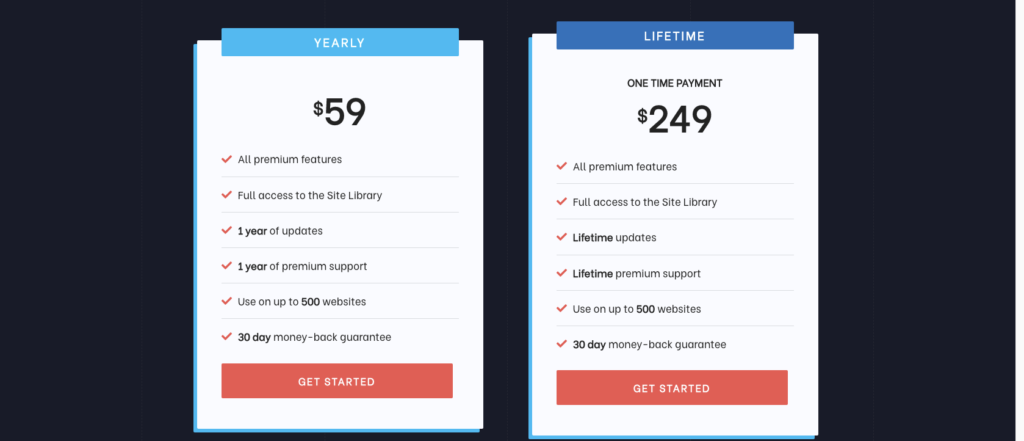
If you are good with the theme then let’s discuss all the mandatory plugins which are collections of free plugins and good enough to start a blog.
The actual price of the GeneratePress theme is $59 But I am providing only Rs 99/- Only for New Bloggers Click Here
Best WordPress Free Plugins
The major advantage of WordPress over Blogger is the ability to install plugins, which make your job easier to customize or automate your site.
Hence below-listed plugins are the mandatory plugins, which every website should have, which are focused on improving performance, security, SEO, etc.
#1: Security Plugin: Jetpack
Jetpack is a wordpress.com security feature and by default, it will be installed into your WordPress site.
To activate Jetpack features, simply create your free account on wordpress.com and link that with wordpress.org.
This plugin ensures high security and also monitors your site in case it is down. However, Akismet Anti-spam is the most recommended plugin for every new blog.
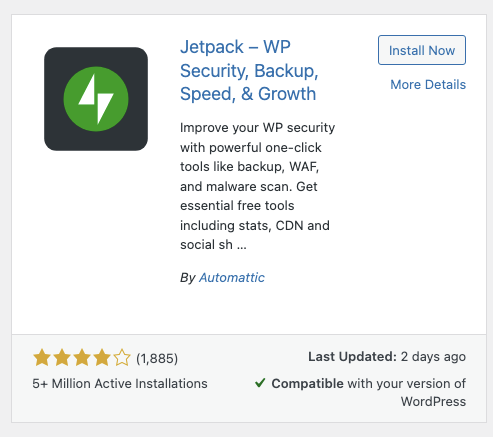
#2: On Page SEO Plugin : Yoast SEO And RankMath
When you write any blog post the primary thing is to write a post in such a way that it optimizes around the search engine need.
In this list, you can use Yoast SEO, which is the most popular plugin and almost every single blogger is using Yoast SEO Plugin.
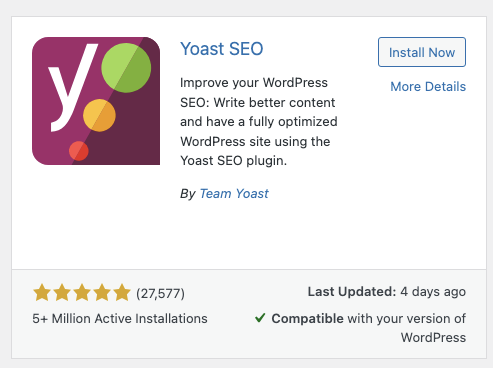
Yoast SEO has a few features like the generation of sitemap and ping to search engine and give you an on-page SEO score and suggestions.
Its free plan will allow you to optimize for only a single keyword.
However, Yoast SEO pro plan will allow you to optimize for more than 5 keywords and many more advantages.
RankMath is another popular plugin introduced recently which has everything that Yoast is offering in Free and Pro plans, so you can try the same but I suggest your priority should be Yoast.
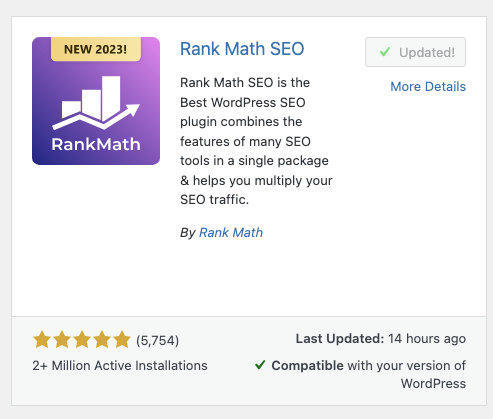
#3: Image Optimizer: Smush
The use of a large number of media on your website causes it loaded and your website page loading speed will get increases hence you can use the best image optimizer plugin.
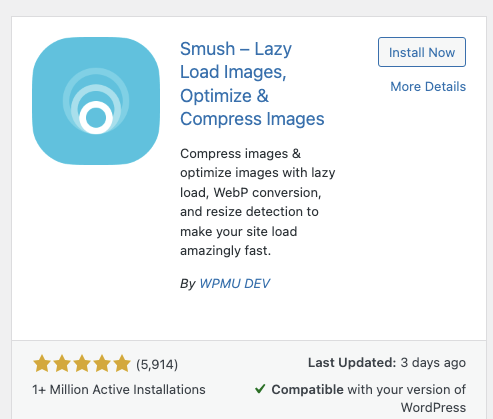
#4: Caching or Performance plugin: W3 Total cache
Website loading speed is very important and if you are purchasing shared hosting then it is must recommend using any caching plugin which creates caches in the user browsers.
This means for the definitive duration of time if the same user visits your site again and again then this time data will be loaded from his cache and will be faster and no load on your server.
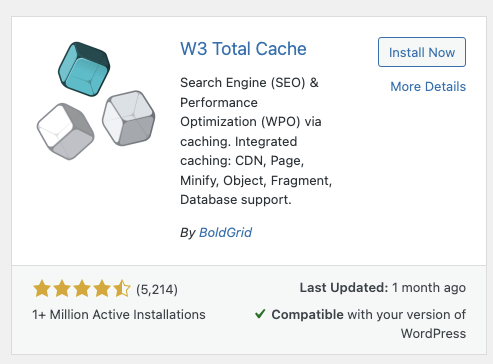
Other advantages are, you will use a custom theme hence using this plugin you can minify CSS, HTML, and javascript codes and the site will load faster.
Earlier I was using W3 Total cache which is a free plugin but now I am moved to WP Rocket premium, hence I recommend using W3 Total cache first then later you can migrate to WP Rocket.
#5: Fix 404 Error: Broken Link Checker And Redirection
If you focus on SEO then the primary thing is to check that your site should not have any broken links.
This means, if you have linked your post A with another post-B with Anchor text but that B post no more exists.
Then, if somebody clicks to site A anchor text there will be a 404 error.
Which increases the bounce rate and bad impact on SEO, hence you have a few plugins in place to identify and fix them asap.
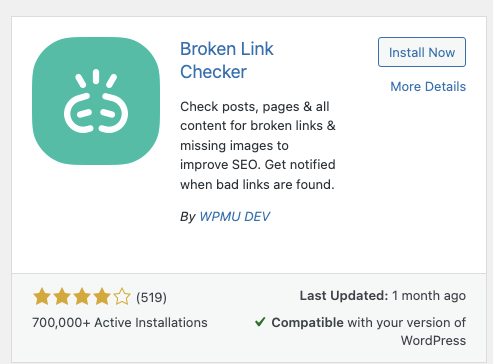
Use a Broken link checker which will auto-identify your site pages, anchor text, and URL which are broken or their linked pages no more exist, in a common window.
So either, you can fix those anchor texts by pointing them to new pages or fixing them by removing links.
However, the Redirection plugin will help you in case you are changing your blog post URL.
This means that the initial URL is www.example.com/abc/test.html and is now changed to www.example.com/xyz/test.html.
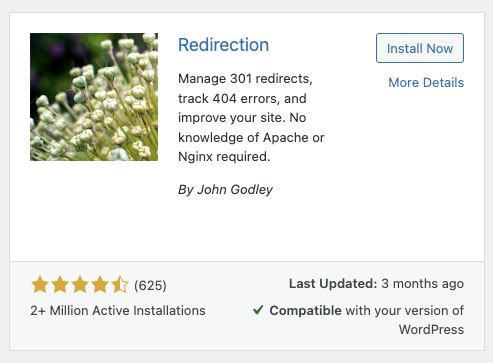
Then if a user clicks on the first URL there will be a 404 error because you have already changed to a new one, using the redirection plugin, you can route every user to a new link without any issue.
It is especially useful in changing the permalink format or shifting the blog from Blogger to WordPress.
#6: WordPress Editor Plugin: Advance Editor
By default in the WordPress editor, you will have a classic block editor, which is known as Gutenberg block editor but we are familiar with an editor that looks like your Google Doc.
Hence using the Advanced Editor plugin you will get a classic editor with easy to use interface and options.
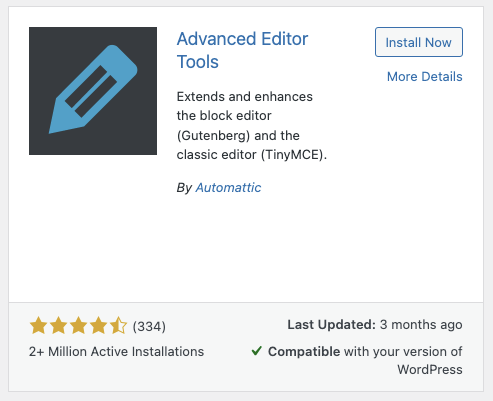
I am using this as a default plugin on my every WordPress editor as it improved my productivity and you can use the same as it is free.
#7: Website Backup Plugin: UpDraft Plus
As I said, WordPress is a self-hosted platform where you need to care about website backup in case the site got hacked or the server crashes.
If you have taken Hostinger hosting then they offer free website backup but still, I recommend holding your backup with you and the best free plugin is UpDraftPlus.
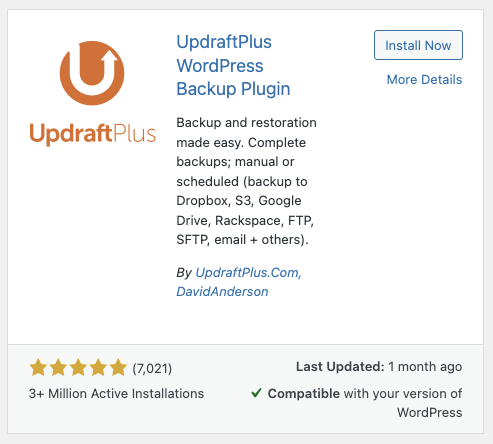
Its free plan will allow you to take website database, plugin, files, theme, etc to your drive or local file repository and that is for free but you need to take a backup manually which is a single-click process.
In the premium plan, they will offer you an automatic scheduled backup, which I suggest is not needed and only needed if you have no time to click a button which hardly takes you 2-3 seconds.
#8: Auto Ads placement plugin: Ad Inserter
If you plan to monetize your blog with Google Adsense then you don’t need to copy Adsense code on every page of your website which is a hectic job.
Using the AdInserter plugin, you can place the code in the plugin and it will auto-apply on your complete blog website, easy and simple but it only works for Desktop sites, not for the AMP version.
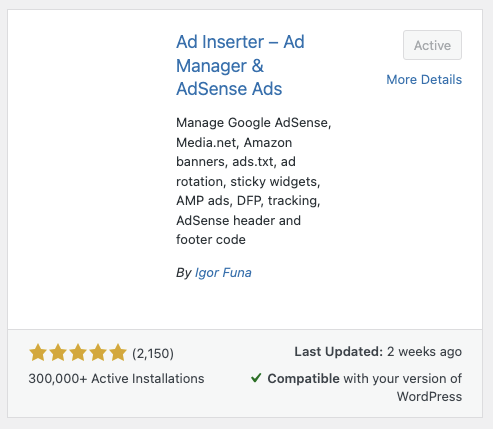
If need detail on AMP version do comment or drop me a message, and I will guide you on the same.
I hope you got the importance of each plugin and that only these many plugins are required to start any blog which ensures everything that a blog needs.
Bonus Tip : Generatepress is the most recommended theme and in plugins, as a beginner, you can start with free plugins but make sure Ad Inserter does not support the AMP version of your site.
Step 9: How to Write 100% On-Page SEO Blog Post?
On-Page SEO
When it comes to optimizing blog posts, on-page SEO is crucial. Essentially, on-page SEO refers to optimizing individual web pages in order to rank higher and attract traffic from search engines. Here, we will explore different on-page SEO elements and provide tips on how to make your content search engine-friendly.
Headlines & Subtitles
An effective headline is crucial in catching your reader’s attention and encouraging them to continue reading. Here are some tips on creating headlines and subtitles that can grab your reader’s attention:
How to Create Headlines That Grab Attention
- Use action verbs to create a sense of urgency or excitement. For example, instead of using “Ways to Save Money,” use “Save Money Now with These Easy Tips.”
- Consider using numbers in your headlines. Listicles are popular because they are easy to read and scan.
- Keep it short and sweet. A concise headline is easier to read and remember.
- Use emotional triggers to create a connection with your readers. For example, “How to Get Your Dream Job and Live Your Best Life.”
The Importance of Headers and Subtitles
Headers and subtitles break up your content into smaller, more manageable sections. This makes it easier for readers to scan through your content and find the information they are looking for. Headers and subtitles also make your content more visually appealing and help with SEO.
Content Structure & Formatting
The way you structure and format your content can have a huge impact on how it is perceived by your readers and search engines. Here are some tips on how to write quality content and format it properly:
The Art of Writing Quality Content
- Start with an attention-grabbing introduction. This should give readers a reason to continue reading.
- Utilize storytelling techniques, personal anecdotes, and examples to make your content more engaging.
- Use active voice and avoid passive voice. Active voice is more engaging and easier to read.
- Write in short paragraphs. This makes your content easier to read and keeps your reader’s attention.
- Edit, proofread, and revise your content to ensure clarity and accuracy.
Formatting Tips and Tricks
- Use short sentences and paragraphs to keep your content engaging and easy to read.
- Use subheadings to break up your content into smaller sections.
- Utilize bullet points and lists to make your content more visually appealing and easier to read.
- Use bold and italic text to emphasize important points.
- Use high-quality images and videos to make your content more engaging.
Optimize URLs and Permalinks
Your URL and permalink structure can also affect your SEO. Here’s how you can optimize them:
- Use short and descriptive URLs that contain your keywords.
- Use hyphens to separate words in your URLs.
- Avoid using special characters in your URLs.
- Use a clear and concise permalink structure.
Optimize Meta Tags
Meta tags are snippets of code that provide information about your webpage to search engines. Here are some meta tags that you should optimize:
Title Tags
Title tags are the titles of your web pages that appear in search engine results. They should be around 60 characters or less and include your primary keyword.
Meta Descriptions
Meta descriptions are short blurbs that appear below your title tag in search engine results. They should be around 155 characters or less and include your primary keyword.
Meta Keywords
Meta keywords are a list of keywords that tell search engines what your content is about. They are not as important as they used to be, but you should still include them.
Internal and External Links
Link building is an important part of SEO. Here are some tips on how to build internal and external links:
Link Building Techniques
- Guest post on other websites in your niche.
- Use social media to promote your content and attract backlinks.
- Link to other relevant content on your website.
- Conduct broken link outreach.
The Importance of Anchor Text
Anchor text is the clickable text that is used as the link. It should be descriptive and related to the content that it is linking to.
Page Load Speed
The speed at which your web pages load can also affect your SEO. Here’s how to improve your page load speed:
- Use a fast and reliable hosting service.
- Optimize your images and videos for the web.
- Use a caching plugin or service.
- Minimize your website’s code and remove unnecessary plugins.
Mobile Optimization
Mobile optimization is becoming increasingly important in today’s world. Here’s why you should optimize your website for mobile devices:
Why Your Site Needs Mobile Optimization
- More and more people are using mobile devices to browse the web.
- Mobile users have different browsing habits and needs than desktop users.
- Google gives preference to mobile-friendly websites in search results.
Mobile-First Indexing
Mobile-first indexing means that Google uses the mobile version of your website to rank your pages. This means that if your website is not mobile-friendly, it can hurt your search rankings.
Images
Images are an important part of content creation. Here are some tips on how to optimize your images for SEO:
- Use high-quality and relevant images.
- Include alt text that is descriptive and contains your keyword.
- Compress your images to reduce page load speed.
Content Creation
Creating quality content is one of the most important factors in generating traffic to your blog. Here’s how to create content that is both informative and engaging:
Keyword Density and Placement
- Use your primary keyword in your headline and throughout your content.
- Avoid keyword stuffing, which can hurt your SEO.
Quality vs. Quantity: The Importance of Content-Length
- Longer content tends to perform better in search rankings.
- Focus on creating in-depth and valuable content.
Diverse Content Creation
Create a variety of content types to keep your readers engaged, including:
- Infographics
- Video content
- Audio content
Keyword Density and LSI Keyword
Never try to manipulate the search engine by inserting keywords everywhere, as it looks unnatural and it is recommended that your keyword density must be between 1-1.5%.
This means, if your blog post length is 1000 words then make sure to use the focus keyword only 10-15 times but start including the LSI keyword and you know how to get the LSI keyword from the SERP.
Sprinkle the LSI keyword everywhere in the blog post as Google considers both keywords the same.
All these are major areas to focus on from the On-Page SEO perspective to optimize your blog post and to verify all these parameters you can use SEO plugins, they will guide you on all these.
Just enter the focus keyword and rest it will guide you on what needs fixes and what does not.
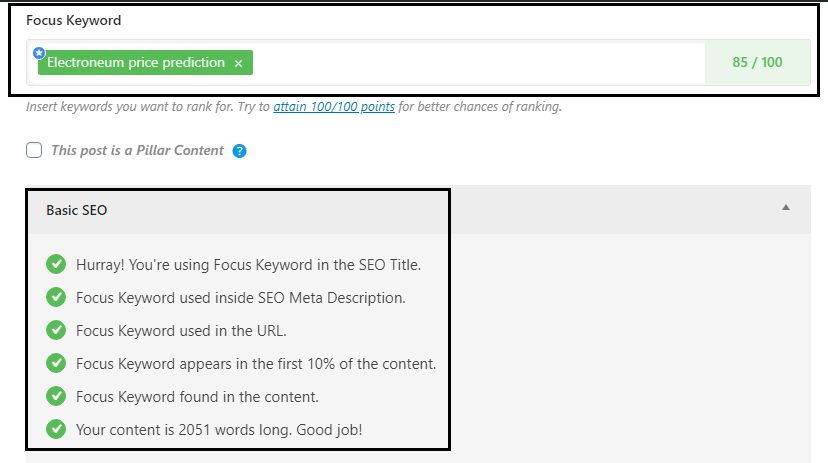
Technical SEO
In addition to on-page SEO, it’s important to have a strong technical foundation for your website. Here are some technical SEO elements to focus on:
Robots.txt
A robots.txt file is used to tell search engines which parts of your website you don’t want to be indexed.
XML Sitemap
An XML sitemap is a file that lists all of the pages on your website in a format that search engines can easily read.
Canonicalization
Canonicalization is the process of telling search engines which version of content is the original.
HTTP Headers
HTTP headers are pieces of code that help establish a connection between your website and the web server.
HTTP Status Codes
HTTP status codes indicate the status of your web pages to search engines.
JavaScript & SEO
JavaScript can have a negative impact on your SEO if it is not used correctly. Here’s how to use JavaScript properly:
- Load your JavaScript files asynchronously.
- Use external JavaScript files instead of inline code.
- Use JavaScript sparingly.
Measuring and Analyzing Your Results
Finally, to improve your blog post’s on-page SEO score, you should be able to measure and track your results. Here’s what you need to know:
Google Analytics
Google Analytics is a free tool that can help you track your website’s traffic and performance.
Google Webmaster Tools
Google Webmaster Tools provides valuable insights into how search engines are crawling and indexing your website.
A/B Testing
A/B testing is the process of testing two different versions of a website or ad to see which one performs better. Use it to determine which changes are effective in improving your on-page SEO.
How to Write Reader-Engaging Blog Posts
If you are good with On-Page SEO technical SEO techniques then the next part is to learn what should be your focus to grab the reader’s attention and most engagement and here are my tips to work on.
- Always include an odd number in Title, which grab readers’ attention and you will get more clicks in Google SERP and result in more traffic to a website.
- Make your paragraph sentences should be shorter than 2 lines, this is a best-copywriting skill and suggested to everyone.
- Always focus on the first 100 words, which will decide whether your reader will read a complete blog post or not, so make sure to give them the reason for excitement, I include the problem which I am solving.
- Always include the conclusion and try to provide something different they haven’t heard in the blog post and route them to another post on your website.
- Try to grab user attention by solving their queries within the blog post, do not wait for the user to comment, fix the same in the blog post itself.
- Always maintain a positive mood, and try to include words like Isn’t it interesting? , I hope you are enjoying it it. I am sure you agree with me. like sentences will always create answers Yes in the reader’s mind.
Bonus Tip :If you are concern about post word length then a study says all the top-ranking pages average post length is around 1890 words, so your post must be more than 1500 words.
Step 10: How to Promote Blog Post – Off Page SEO?
Understanding Off-Page SEO
Off-Page SEO refers to the efforts made outside of your website in order to improve its search engine rankings. The main goal of Off-Page SEO is to create backlinks, which are links from other websites that direct users to your website.
Definition of Off-Page SEO
Off-Page SEO is the optimization process performed outside of a website, used to improve the website’s search engine ranking and online presence. It involves techniques such as link-building, social media, influencer collaborations, guest blogging, and more.
Factors that Influence Off-Page SEO
Various factors can influence Off-Page SEO, including the number, quality, and relevance of backlinks, social media engagement, brand mentions, and influencer collaborations.
Comparison between Off-Page SEO and On-Page SEO
On-Page SEO refers to the optimization efforts made within your website, targeting factors such as content, keywords, meta tags, and more. Whereas Off-Page SEO focuses on external factors such as link building and social media engagement.
Importance of Off-Page SEO in Promoting a blog post
Off-Page SEO plays a vital role in promoting a blog post. By creating backlinks on other authoritative websites, you can improve your website’s rankings in search engine results pages (SERPs). This, in turn, can increase your website’s traffic and promote your blog post to a larger audience.
Identifying Your Target Audience
To effectively promote your blog post, it is important to identify your target audience.
Importance of understanding your target audience
Knowing your target audience helps you tailor your content, messaging, and marketing efforts specifically to them. This leads to increased engagement, better conversion rates, and more effective promotion.
Tools to help identify your target audience
There are various tools available to help identify your target audiences, such as Google Analytics, social media analytics, and keyword research tools.
Creating reader personas
Creating reader personas can help you develop a deeper understanding of your target audience, including their interests, goals, and pain points. This can help you create more targeted content and promotional strategies.
Mapping user journey
Mapping the user journey involves identifying the steps users take from discovering your blog post to engaging with it. By understanding this process, you can optimize it and make it more effective in promoting your blog post.
Creating High-Quality Content
High-quality content is essential to promoting your blog post and improving your website’s rankings in SERPs.
Importance of creating high-quality content
High-quality content not only improves your website’s ranking in SERPs but also increases engagement and encourages backlinks.
Characteristics of high-quality content
High-quality content is informative, authoritative, and engaging. It uses images, videos, and infographics to enhance its appeal and is tailored to the target audience.
Tips for creating shareable content
Creating shareable content is key to promoting your blog post. Some tips include using attention-grabbing headlines, incorporating social sharing buttons, and creating content that elicits an emotional response.
Using Social Media
Social media can be a powerful tool in promoting your blog post.
Benefits of using social media
Social media increases engagement, promotes brand awareness, and can lead to more backlinks.
Best social media platforms for promoting blog posts
The best social media platforms for promoting blog posts include Facebook, Twitter, LinkedIn, and Pinterest. Each platform offers different benefits and caters to different target audiences.
Tips for promoting blog posts on social media
Some tips for promoting blog posts on social media include using eye-catching images, posting at the right time, and engaging with your followers.
How to engage with your followers and increase post visibility
Engaging with your followers involves responding to comments, sharing content, and starting conversations. This helps increase post visibility and strengthens your relationship with your audience.
Building Relationships with Influencers
Influencers can help promote your blog post to a larger audience and improve your website’s rankings in SERPs.
Benefits of collaborating with Influencers
Collaborating with influencers increases brand awareness, promotes engagement, and can lead to more backlinks.
Finding the right influencers
Finding the right influencers involves identifying those with a similar target audience, who are authoritative in their niche, and who have a large following.
Tips for building relationships with Influencers
Some tips for building relationships with influencers include personalizing your outreach, offering something of value, and maintaining a long-term relationship.
Creating valuable content for influencers
Creating valuable content for influencers involves developing content tailored specifically to them and their audience. This can increase the likelihood of them sharing and promoting your blog post.
Guest Blogging
Guest blogging involves writing blog posts for other websites in your niche, which can help increase backlinks and drive more traffic to your website.
What is guest blogging?
Guest blogging involves writing blog posts for other websites in your niche, which can help increase backlinks and drive more traffic to your website.
Benefits of guest blogging
Guest blogging increases brand exposure, improves your website’s ranking in SERPs, and can lead to more referral traffic.
Finding the right blogs to guest post on
Finding the right blogs to guest post on involves identifying those with a similar target audience and authoritative in their niche.
Writing the perfect guest post
Writing the perfect guest post involves using attention-grabbing headlines, providing informative content, and using images and videos to enhance engagement.
Forum and Community Participation
Participating in forums and online communities can help increase your website’s visibility and drive more traffic.
Importance of forum and community participation
Participating in forums and online communities increases brand awareness, drives more referral traffic, and can lead to more backlinks.
Finding the right forums or communities
Finding the right forums or communities involves identifying those that cater to your target audience and are active and engaged.
Tips for participating in forums and communities
Some tips for participating in forums and communities include engaging with others, answering questions, and providing valuable insights.
How to promote blog posts in forums and communities
Promoting your blog post in forums and communities involves using attention-grabbing headlines and providing informative content.
Email Marketing
Building an email list and using email marketing can help increase engagement and drive more traffic to your website.
Importance of building an email list
Building an email list helps you maintain contact with your audience and increases engagement.
Best practices for email marketing
Some best practices for email marketing include personalizing your messaging, using attention-grabbing subject lines, and segmenting your audience.
How to write a compelling email
Writing a compelling email involves tailoring your messaging to your target audience, using images and videos to enhance engagement, and providing value.
Benefits of email marketing in promoting blog posts
Email marketing increases engagement, promotes brand awareness, and can lead to more backlinks.
Backlinking
Backlinking involves creating links from other authoritative websites to your website, which can help improve your website’s ranking in SERPs.
Explanation of backlinking
Backlinking involves creating links from other authoritative websites to your website, which can help improve your website’s ranking in SERPs.
Importance of backlinking
Backlinking is essential to Off-Page SEO and can help drive more traffic to your website.
Best practices for backlinking
Some best practices for backlinking include using natural, relevant, and high-quality links, and avoiding black hat SEO techniques.
Tips for creating natural backlinks
Some tips for creating natural backlinks include creating high-quality content, engaging with your audience, and collaborating with influencers.
Using Video Content
Video content is highly engaging and can help promote your blog post to a larger audience.
Benefits of video content
Video content increases engagement, promotes brand awareness, and can lead to more backlinks.
Tips for creating engaging video content
Some tips for creating engaging video content include using attention-grabbing thumbnails, providing informative content, and maintaining a consistent brand image.
Best platforms to distribute video content
The best platforms to distribute video content include YouTube, Facebook, Instagram, and LinkedIn.
Integrating video content on your blog
Integrating video content on your blog involves embedding videos into your blog posts, using attractive titles, and optimizing your video content for SEO.
Start Creating Backlinks on Other Websites
Backlinks means to create references for your site on another website, understand this in a way like your website is A and another website is B.
If A creates any anchor text on B which points back to A then it will be considered that A has received backlinks from B and these backlinks will be of two types.
Do Follow backlinks: If a link created on other blog posts is Do follow then Google crawler will pass through that link and visit your site and improve your site authority and ranking.
No Follow backlinks: If you got no follow backlinks from another site then Google crawler won’t pass through that link and you will not get any advantage but any manual user can click to that link and you may have traffic.
Guest Post on Other High Authority websites
It is always recommended, to publish a guest post on another blog and give a link back to your site, but make sure the guest blog must have high domain authority.
You can find guest post opportunities by searching in Google with different patterns like.
Keyword+ “Write for us”
Keyword+ “Guest post”
Keyword+ “share with us”
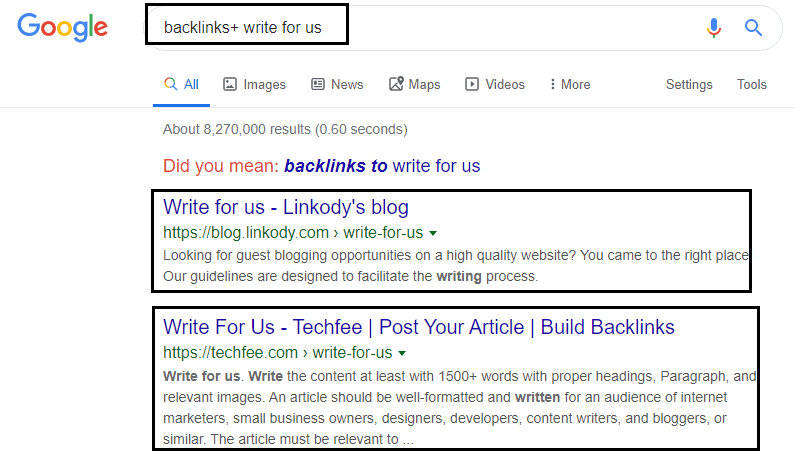
You can drop an email to the blog owner and request to publish a post on a specific topic.
But it is hard for a new blogger to get a free guest post, so if you are not getting any opportunity then go for the second-best choice.
Broken Link and Link Replacement Opportunity
Find out a blog that has given backlinks to any blog related to your topic, but that linked blog no more exists.
Then there is an opportunity for you to notify the blog owner that you found a broken link on their blog post and you have written a similar topic best content and if they want they can replace it with your URL.
You can use Email requests like this.
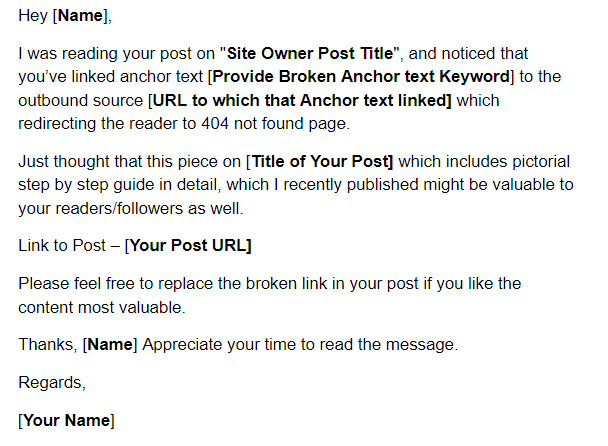
Broken link-building is a very effective technique to get backlinks and in most cases, it works fast as compared to other link-building strategies.
The other approach is to find out a blog that has given a backlink to another blog in your niche.
Now write some great content compare to the content they have linked and drop him an email to inform him about your content.
You can use the below email template which I use all the time.
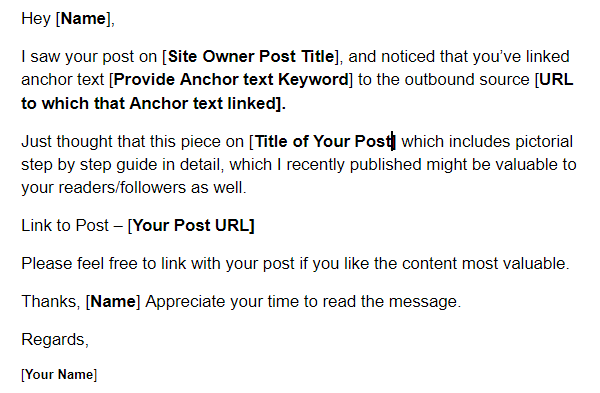
Sometimes, it is worth contacting the blog owner in a two-step process, where first notify them of the issue with the broken link and you have the best content to replace that with yours.
If he replies to that email then shares your post link, this increases more chances of linking and improve the trust.
Now I will leave this with you how you want to approach it.
Are you enjoying it?
Weekly Roundup and Resource Page Link building
If you have not observed then there are a huge number of websites that are publishing the best roundup post on a weekly or daily basis.
They do collect the best blog posts and share the link to those posts or pages every week on their site, so you can connect with them by searching in Google like:
“Keyword”+weekly roundup
“Keyword”+monthly roundup
“Keyword”+daily roundup
Drop them an email and notify them that you have written great content that is worth including in their weekly or daily or monthly roundup posts.
Similarly, you can create a resource page, which is a collection of the best posts such as the best link-building posts, the best SEO posts, or anything else.
After publishing all these resource links, you can connect with those site owners and notify them, you have included their posts.
So the chances are very high that they may link your post on their site.
Create Web 2.0 And Social Bookmarking Sites
No one can deny the importance of backlinks from Web 2.0 sites, so go and start creating backlinks to your homepage.
This gives a signal to Google that your site is existing and it has some references on different platforms, here are a few suggestions.
- Create an account on WordPress.com and publish 500 words posts and link back to your site.
- Create an account on blogger.com and publish 500 words posts and link back to your site.
- Create an account on tumblr.com and publish 500 words posts and link back to your site.
On other sites start creating backlinks on social bookmarking sites like Facebook, Twitter, and many other social media sites.
Our objective is to create a network of references, so Google knows that you exist else you will lose the game of ranking.
Congratulations !! Now you are a master of blogging skills.
It is obvious that there are plenty of things to learn and explore but now your fundamentals are strong enough to grow your blog.
So let’s learn, the most awaited topic how to make money from a blog or how to monetize blog posts to make passive income.
Bonus Tip : Google cares about the quality backlinks not on quantity so avoid getting backlinks from the Spammy sites and always focus on high authority sites.
Step 11: How To Make Money Or Monetize Blog?
Why Monetize Your Blog?
Monetizing your blog allows you to earn money through the content you create. This money can help you cover the costs of running your blog and even generate significant income. Monetization can also incentivize you to create high-quality content that resonates with your audience.
The Challenges to Monetization
Monetizing your blog isn’t always easy; it requires planning, patience, and a great deal of effort. Some challenges that bloggers face include a lack of knowledge in monetization methods, a lack of patience to see results, and struggling to find the right monetization strategy that fits their niche.
Ad-based Monetization
Make Money Using Adsense Or Ad Networks
Almost every blogger is familiar with Google Adsense, the biggest advertising network.
They offer money to the publisher for placing ads on their website and if any of your readers clicks or views those ads then as a website owner you will get money.
Google Adsense ads will pay between $0.001 to $50 or even more for one click on ads and this is known as cost per click or CPC.
This means you will get money not only for displaying ads which they call impressions but also if any reader will click on those ads.
Here is a screenshot for one of my sites Google AdSense earning proof which has only 200 visitors per day.


In summary, you will be paid with Ads impressions and clicks but how to display ads on the website.
Once your blog is ready, you have to apply for Google Adsense. If your blog will get approved then you are eligible to display ads on your website.
Here are a few checks you need to make sure before applying Google Adsense.
- Make sure your website should have a custom domain like gTLD or ccTLD, never applied with a free domain like blogspot.com or any other.
- Your domain must be older than 3 weeks, this seems legit to the reviewer.
- Write at least 15-20 posts of an average length of 1000 words.
- The website must have a few mandatory pages such as About Us, Privacy Policy, Contact Us, and Disclaimer Policy.
Ideally, wait for 3 weeks to get it reviewed and approved and if not approved then fix all the issues and reapply after 30 days.
In case, you did not get approval then you can try the best Adsense alternatives, which offer less advertising money but are closely similar to Google Adsense.
- Media.net: Ad network offered by Bing and Yahoo offers money in the form of CPC and RPM
- AdThrive: They will ask you for the minimum traffic of 100k page views per month but you will get money for both CPC and RPM.
- Sovrn: It offers ad revenue only based on impressions not on the ad network.
- Ezoic: It offers the best ad placement using AI and offers ad revenue only based on impressions.
Make Money Using CPA Marketing
CPA stands for cost per action, which means if your reader will perform any action on your website you may have the chance to make money through that.
How CPA works?
Maxbounty is a very big platform, which offers a website owner close to $0.75 to $4 for capturing leads from your website.
Here leads mean capturing the user’s Email id, name, or contact number, so you can use a lead magnet which is ideally an email subscriber popup on your website.
If any reader will put his or her detail into that subscriber popup, in return you will get an instant CPA commission based on the detail the user provided.
The more you will get if the reader provided full details like Name, E-mail including his mobile number.
Affiliate Marketing
What is Affiliate Marketing?
Affiliate marketing involves earning a commission when someone clicks on a referral link and makes a purchase. Bloggers can earn money by promoting products or services that align with their brand, niche, or audience.
Pros and Cons
Pros:
- Passive income
- No inventory or shipping required
- Can promote products you believe in
- High earnings potential
Cons:
- Need to disclose affiliate links
- May require a specific audience or niche
- High competition in certain niches
- May require significant effort to become profitable
How to Implement Affiliate Marketing?
To start with affiliate marketing, research different affiliate programs and choose ones that align with your content or audience. Be transparent with your audience and disclose affiliate links. Ensure that you promote products that you believe in and are relevant to your audience.
There are a few most popular networks.
- Amazon Associate: Amazon affiliate program is the most popular affiliate network, no matter what the user is buying but if your reader visited Amazon using your link and bought anything in 24 hours, you will be paid a commission of between 4-12%.
- Hosting Affiliate: This niche is very competitive but if you can make sell using your link you may receive money between $50-$80 depending on the hosting provider company.
- Click Bank: It is a collection of different affiliate products, you can approve your site with click bank and can start making money up to $75 or more for each sale.
- CJ Affiliate: CJ affiliate is a collection of thousands of products, you have to register with CJ and will get an affiliate link for the product, which you can use on your website for promotion.
Affiliate marketing will be best if your site is focussed around a specific niche or micro-niche but be selective with product promotion.
Sponsored Content
What is Sponsored Content?
Sponsored content is when a company pays a blogger to create content that promotes their brand or product. This content should align with your brand and be relevant to your audience.
Pros and Cons
Pros:
- Higher earnings potential
- Can establish partnerships with brands
- Can help increase brand awareness
- Can attract new readers
Cons:
- Need to disclose sponsored content
- May harm user trust if not authentic
- May require significant effort to find partnerships
- May not be suitable for all niches
How to Implement Sponsored Content?
To start with sponsored content, reach out to brands in your niche and pitch your services. Ensure that the content aligns with your brand and audience, and always disclose sponsored content.
Digital Products
What are Digital Products?
Digital products include ebooks, courses, printables, templates, and other types of digital files. Bloggers can sell their unique content or expertise to their audience.
Pros and Cons
Pros:
- High earnings potential
- More creative freedom to sell unique content
- Passive income
- Can establish authority and expertise
Cons:
- Need to create high-quality content
- May require significant effort to create
- May not be suitable for all niches
- May require marketing and promotion to generate sales
How to Implement Digital Products?
To implement digital products, create high-quality content that aligns with your brand and audience’s needs. Decide on the format and pricing that suits your content and audience. Use a platform that enables easy delivery and payment processing.
Services
Monetizing Through Services
Bloggers can offer various services to their audience, including coaching, consulting, copywriting, web design, or any other service that aligns with their expertise.
Pros and Cons
Pros:
- High earnings potential
- Directly exchange services for money
- Establish expertise and authority
- This can lead to long-term relationships with clients
Cons:
- May require a specific skill set
- May not be passive income
- May require significant effort to acquire clients
- May not be suitable for all niches
How to Implement Services?
To implement services, identify the skills and services that align with your brand and audience. Create packages or pricing that suit your content and audience. Use your blog as a platform to promote your services and build relationships with potential clients.
Influencer Marketing
What is Influencer Marketing?
Influencer marketing is when a brand partners with a blogger to promote their products or services. Bloggers should have a substantial following to become an influencer.
Pros and Cons
Pros:
- High earnings potential
- Can establish partnerships and sponsorships
- Can increase brand awareness and reach
- Can attract new readers
Cons:
- May require a substantial following
- Need to disclose sponsored content
- May harm user trust if not authentic
- May not be suitable for all niches
How to Implement Influencer Marketing?
To implement influencer marketing, focus on building a substantial following and establish yourself as an authority in your niche. Reach out to brands that align with your brand and audience and pitch your services. Ensure that the content you create aligns with your brand and audience, and always disclose sponsored content.
Memberships and Subscription-based Products
What are Memberships and Subscription-based Products?
Bloggers can provide exclusive content or services to their audience through memberships or subscription-based products. This monetization method is suitable for those with a dedicated and engaged audience.
Pros and Cons
Pros:
- High earnings potential
- Exclusive content or services
- Can establish a dedicated and engaged audience
- Passive income
Cons:
- Need to produce high-quality, engaging content regularly
- May require significant effort to create a community
- May not be suitable for all niches
- Need to determine the right pricing structure
How to Implement Memberships and Subscription-based Products?
To implement memberships and subscription-based products, identify the content or services that your audience is willing to pay for. Determine the pricing structure and create exclusive content or services that align with your brand and audience. Create a community around the membership and engage with your members regularly.
Hybrid Monetization Strategies
Combining Multiple Monetization Methods
Bloggers can also use a combination of different monetization methods to generate multiple streams of income. A hybrid monetization strategy allows bloggers to diversify their income and mitigate any risks.
Examples and Tips
- Use a mix of passive and active income
- Determine the right balance of monetization methods
- Ensure that your monetization methods align with your brand and audience
Monetizing Your Blog with E-commerce
Integrating E-commerce onto Your Blog
E-commerce allows bloggers to sell physical or digital products directly to their audience. Integrating e-commerce into your blog can help monetize your traffic and audience.
Pros and Cons
Pros:
- High earnings potential
- Direct sales
- Can offer unique products
- Can establish a loyal customer base
Cons:
- Need to handle inventory and shipping
- May require significant effort to create or source products
- May not be suitable for all niches
- Need to determine the right pricing strategy
Examples and Tips
- Use a platform that allows easy e-commerce integration
- Create unique products that align with your brand and audience
- Determine the right pricing structure
Developing a Successful Monetization Plan
Market Research
Market research is essential to monetize your blog successfully. Understand your niche, audience, and competition to come up with a monetization strategy that suits your blog.
Content Strategy
Create high-quality, engaging content that aligns with your brand and audience. Use well-researched keywords to improve your visibility and attract a broader audience.
Branding
Establish consistent branding across your blog, social media, and other online platforms. Ensure that your branding aligns with your niche and audience.
Promotional Activities
Promote your content through various channels, including social media, email marketing, and influencer outreach. Use a mix of paid and organic promotion to reach a broader audience.
Analytics, Metrics, and Assessing ROI
Use analytics and metrics to track and optimize your monetization strategies. Assess your ROI and pivot as needed to maximize your earnings potential.
Avoiding Common Monetization Pitfalls
Lack of Patience
Monetizing your blog requires time and effort. Don’t expect immediate results, and be patient as you establish your monetization strategy.
Overloading Your Blog with Ads
Too many ads can overwhelm or annoy your audience. Find the right balance of ads to maintain a quality user experience.
Losing Your Readership’s Trust
Ensure that your monetization methods align with your brand and audience. Be transparent and disclose sponsored or affiliate content.
Not Investigating Potential Partnerships
Research potential partnerships before entering into any agreements. Ensure that the partnership aligns with your brand and audience.
Pro Tips from Monetizing Pros
Experts’ Insights on Monetization Strategies
Learn from experienced monetizing pros and leverage their insights and strategies. Attend conferences, read blogs and books, and network with other bloggers to gain knowledge.
Their Success Stories
Study the success stories of other bloggers who have monetized their blogs. Learn from their strategies and tactics to replicate their success.
Key Takeaways
Every blog is unique and requires a monetization strategy tailored to its niche and audience. Experiment and test different methods to find the right monetization model. Be patient, authentic, and transparent, and always prioritize user experience.
Monetizing Your Blog: Your Legal Obligations
Disclosure Rules for Sponsored Posts, Advertisements, and Affiliate Links
Ensure that you disclose sponsored content, ads, and affiliate links to comply with legal requirements.
How to Avoid Legal Trouble?
Stay up-to-date with legal guidelines and regulations, and ensure that your content aligns with these requirements. Consult a legal expert if needed.
Scaling up Your Monetization Strategy
Growth Hacking Your Blog
Use different growth hacking tactics to scale your monetization strategy, including social media marketing, influencer outreach, and SEO optimization.
Building a Diverse Monetization Plan
Diversify your income streams by using a combination of different monetization methods. This strategy can help mitigate any risks and maximize your earnings potential.
Adopting New Technologies and Platforms
Keep up with new technologies and platforms that can help you monetize your blog. Stay informed and take advantage of new tools and resources to stay ahead of the competition.
Bonus Tip : If you can build a Niche blog then you have the probability to sell that on Flippa for more than $5000 depends on site, content and its organic traffic.
Wrap Up On How To Start A Blog
If you have read all the steps, then you already knew almost everything that a beginner in blogging needs to start a blog.
This fundamental guide on how to start a blog has polished your skills from the fundamentals of Niche selection to keyword research and writing blog posts to the promotion and ended by monetizing opportunities.
Do remember, learning is a never-ending process and SEO is changing it started with a simple search and now moved to Voice searches like Alexa, Google Home, and many other ways.
Keep reading our blog post and join our E-mail list and social groups to learn more about Blogging and explore more trending.
Now tell me in the comment box what you think about the guide and which type of blog you are planning to start.
